Patch News – October 2025
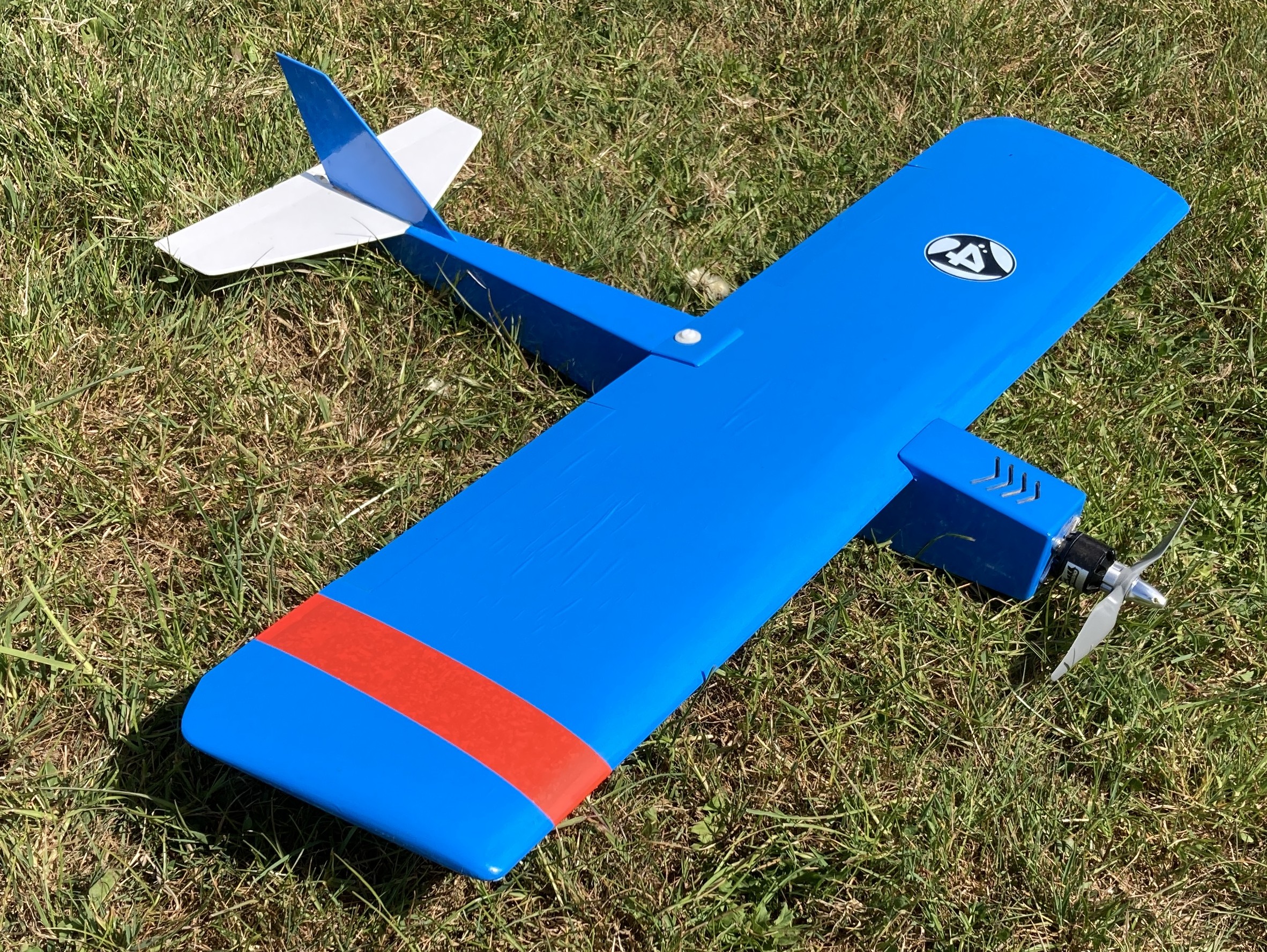 It was a good choice of plane for someone who was determined to fly despite the gale and Dougal flew before we got down to mowing and then flew again when we had finished.
It was a good choice of plane for someone who was determined to fly despite the gale and Dougal flew before we got down to mowing and then flew again when we had finished. 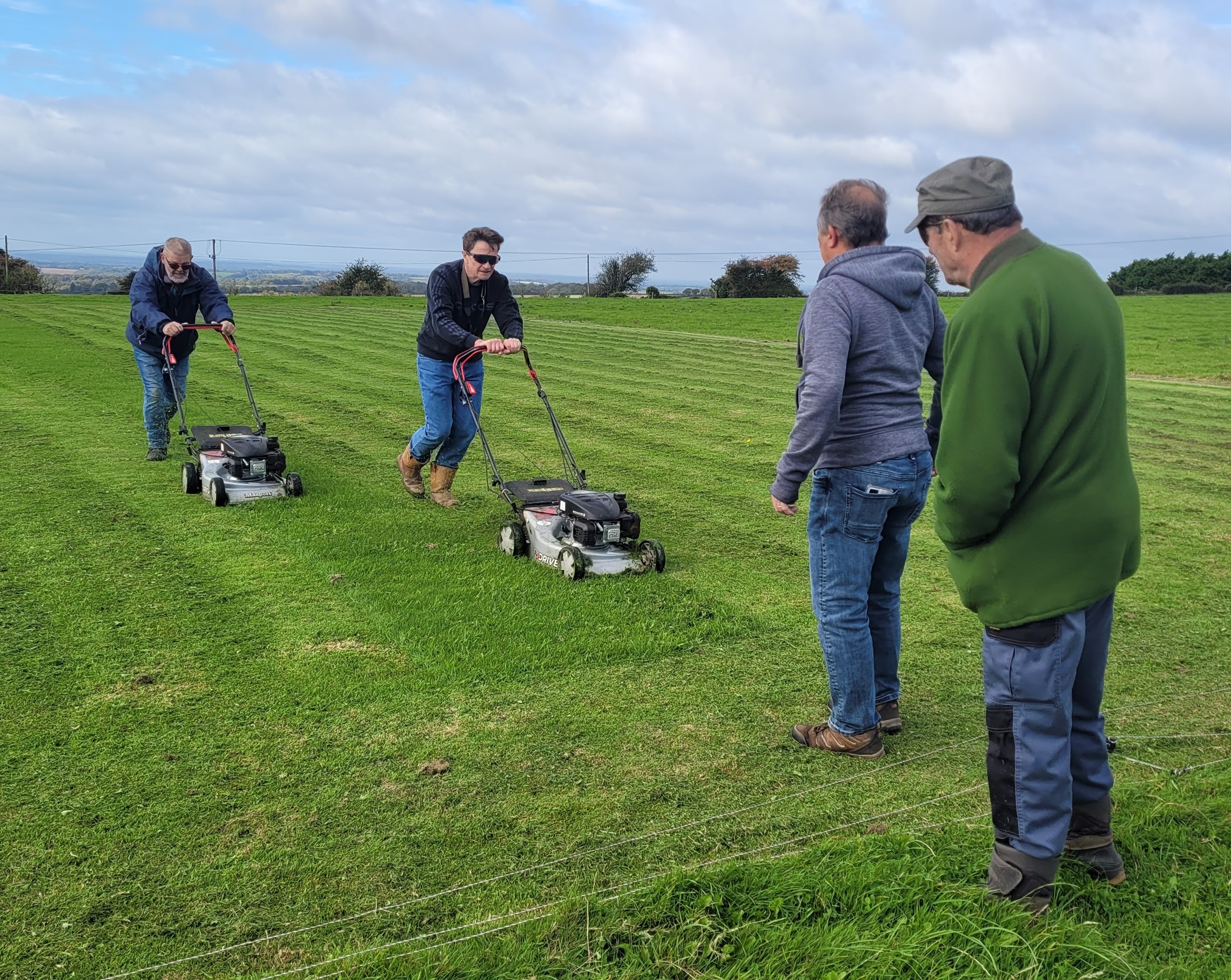 Well done Dougal for showing the rest of us how to do it! Some of Dougal’s in-gale flying can be seen at the start of this month’s video. The patch looked much better once mown that day and better still when 1066 and Woody went up and cut it again on Friday 17th.
Speaking of Woody, it’s hard to believe but he reached the big 70 on Saturday 25th Oct.
Well done Dougal for showing the rest of us how to do it! Some of Dougal’s in-gale flying can be seen at the start of this month’s video. The patch looked much better once mown that day and better still when 1066 and Woody went up and cut it again on Friday 17th.
Speaking of Woody, it’s hard to believe but he reached the big 70 on Saturday 25th Oct.
 He was kind enough to do the right thing and brought cakes along for everyone on Sunday.
On the last Sunday of the month there was quite a brisk north west wind blowing but despite that, Snoopy (aka Patrick Beagles) took the decision to take his BMFA ‘A’ test. Snoopy has been practising hard for the test with his Durafly Tundra in recent months and that is the model he used on the day. He had already asked club examiner Dougal to bring along the necessary paperwork so there was no backing out just because it was windy!
He was kind enough to do the right thing and brought cakes along for everyone on Sunday.
On the last Sunday of the month there was quite a brisk north west wind blowing but despite that, Snoopy (aka Patrick Beagles) took the decision to take his BMFA ‘A’ test. Snoopy has been practising hard for the test with his Durafly Tundra in recent months and that is the model he used on the day. He had already asked club examiner Dougal to bring along the necessary paperwork so there was no backing out just because it was windy!
 Dougal said this about Snoopy’s flight: Patrick put up a very good flight performance given the wind conditions. His simulated deadstick was no problem at all despite the wind and his plane’s rubbish glide angle! I had no hesitation in awarding him a pass.
Dougal said this about Snoopy’s flight: Patrick put up a very good flight performance given the wind conditions. His simulated deadstick was no problem at all despite the wind and his plane’s rubbish glide angle! I had no hesitation in awarding him a pass. 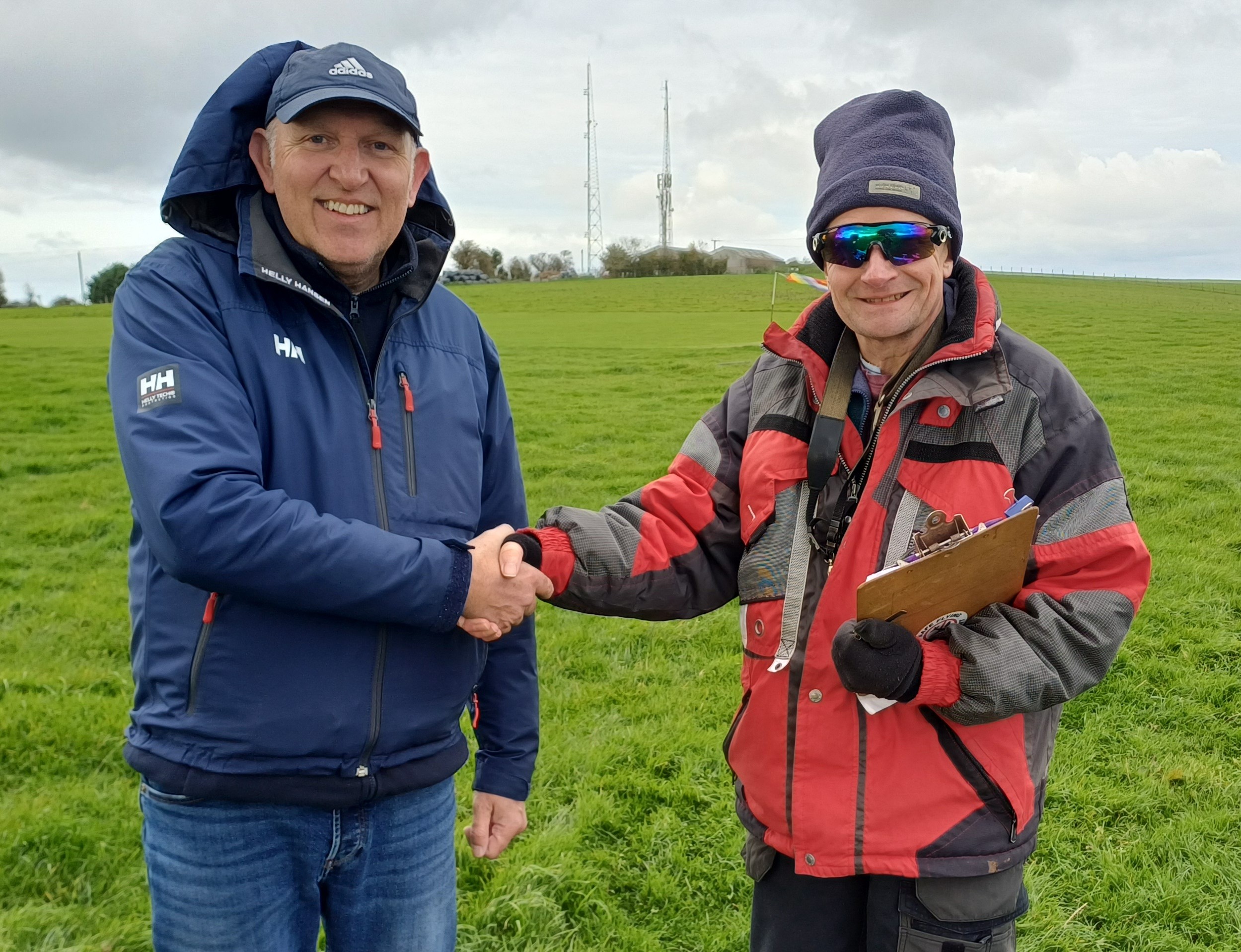 Congratulations Snoopy, a good flight and an excellent result on a less than ideal day.
Several new or revived models were flown in October and I’ll begin with Woody’s Delta.
Congratulations Snoopy, a good flight and an excellent result on a less than ideal day.
Several new or revived models were flown in October and I’ll begin with Woody’s Delta.  The model is a later version of one originally built by 1066 for the club’s Delta competition way back in 2015 when club members built deltas of their own design but they had to have a flat plate wing of a specified size and outline. They then competed in a series of tasks over the following few months, great fun. Some flew better than others but they all flew.
The model is a later version of one originally built by 1066 for the club’s Delta competition way back in 2015 when club members built deltas of their own design but they had to have a flat plate wing of a specified size and outline. They then competed in a series of tasks over the following few months, great fun. Some flew better than others but they all flew.
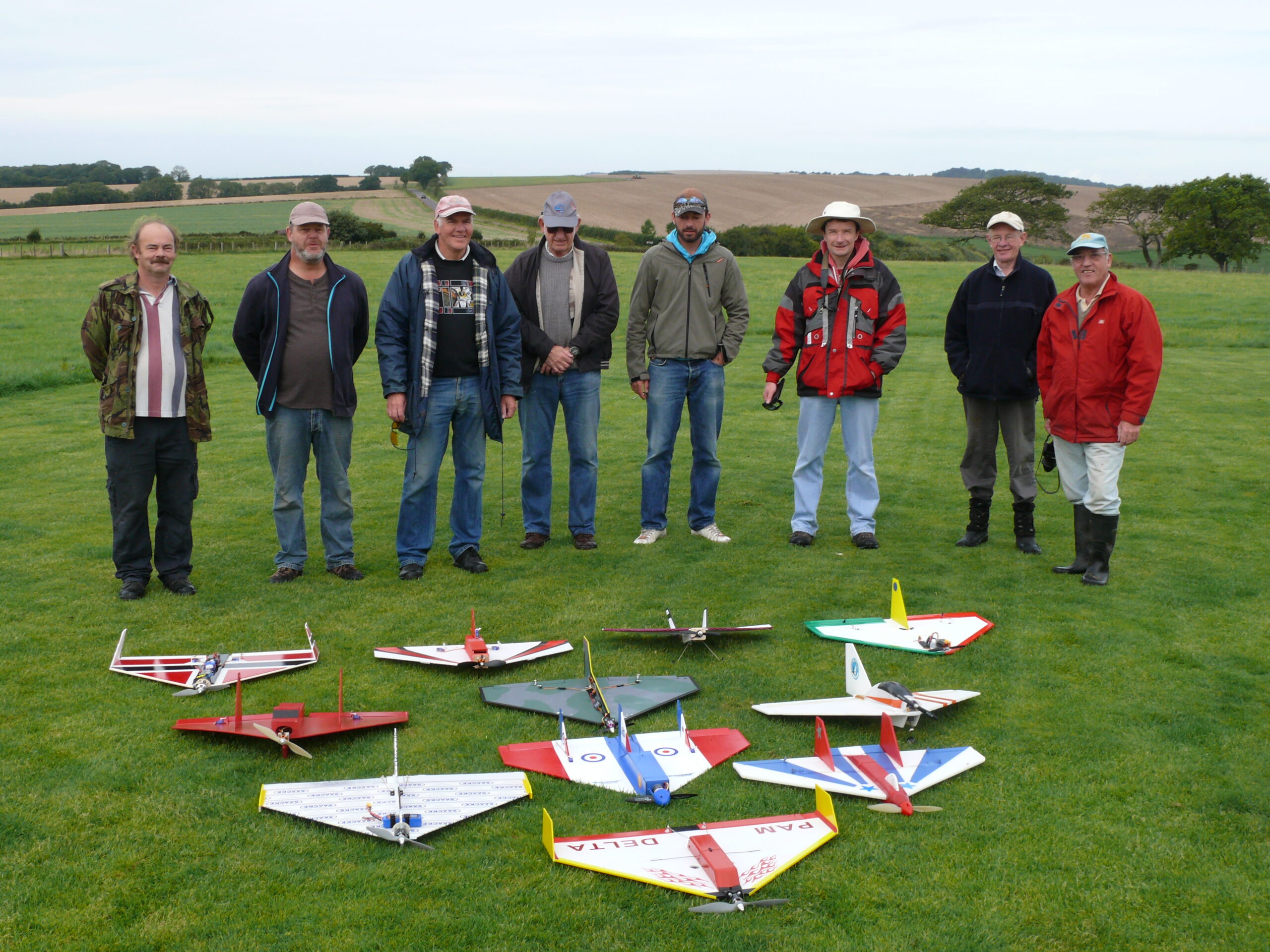 Oh look, ten years on and Dougal is still wearing that same coat! Back to the models now… 1066’s was a good flier and he enjoyed it so much that he built a Mark 2 version that used a Kline Fogleman wing section and it flew even better than the first one pictured below.
Oh look, ten years on and Dougal is still wearing that same coat! Back to the models now… 1066’s was a good flier and he enjoyed it so much that he built a Mark 2 version that used a Kline Fogleman wing section and it flew even better than the first one pictured below.
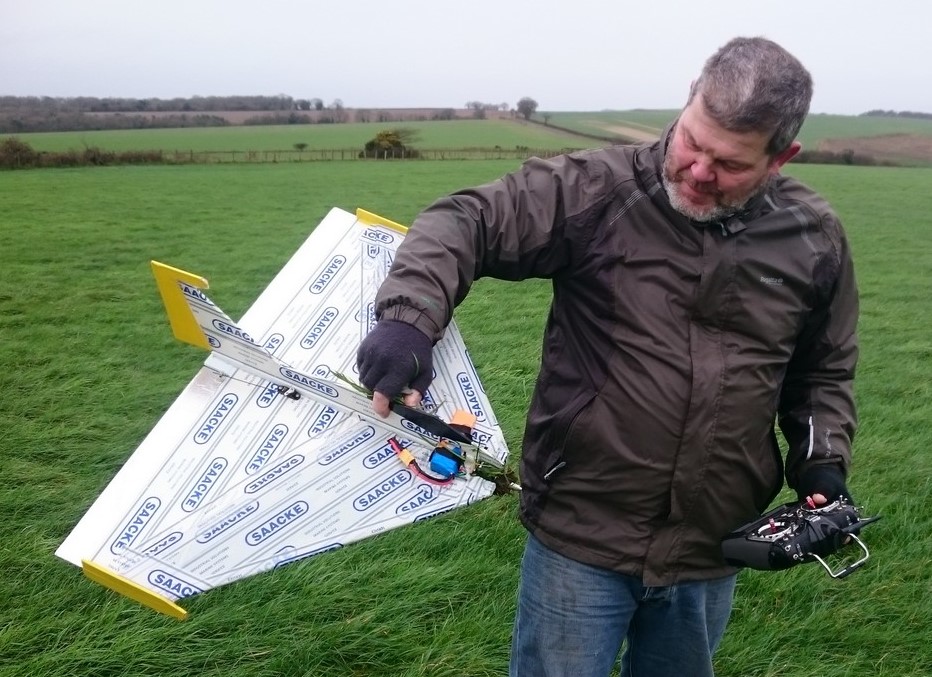 Eventually 1066 got a bit bored with flying the Mark 2 and it was discarded, just cluttering up his workshop, so this month he removed the running gear and passed it on to Woody.
Eventually 1066 got a bit bored with flying the Mark 2 and it was discarded, just cluttering up his workshop, so this month he removed the running gear and passed it on to Woody.
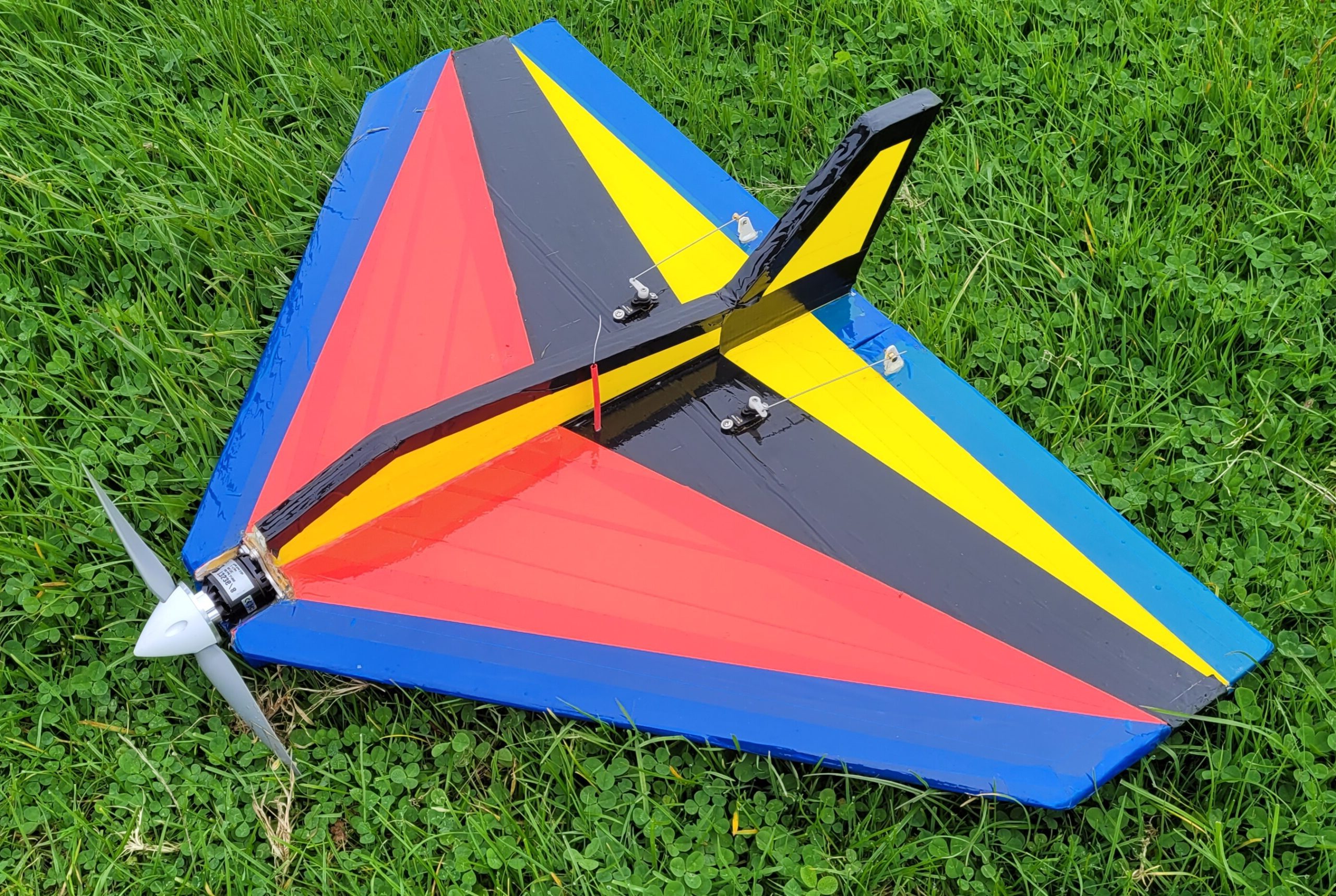 1066 used to fly it with a fairly high KV motor and it was quite fast, but now, Woody has fitted a Tornado Thumper 3536/08 motor powered by a three cell 2200mAh lipo battery.
1066 used to fly it with a fairly high KV motor and it was quite fast, but now, Woody has fitted a Tornado Thumper 3536/08 motor powered by a three cell 2200mAh lipo battery.

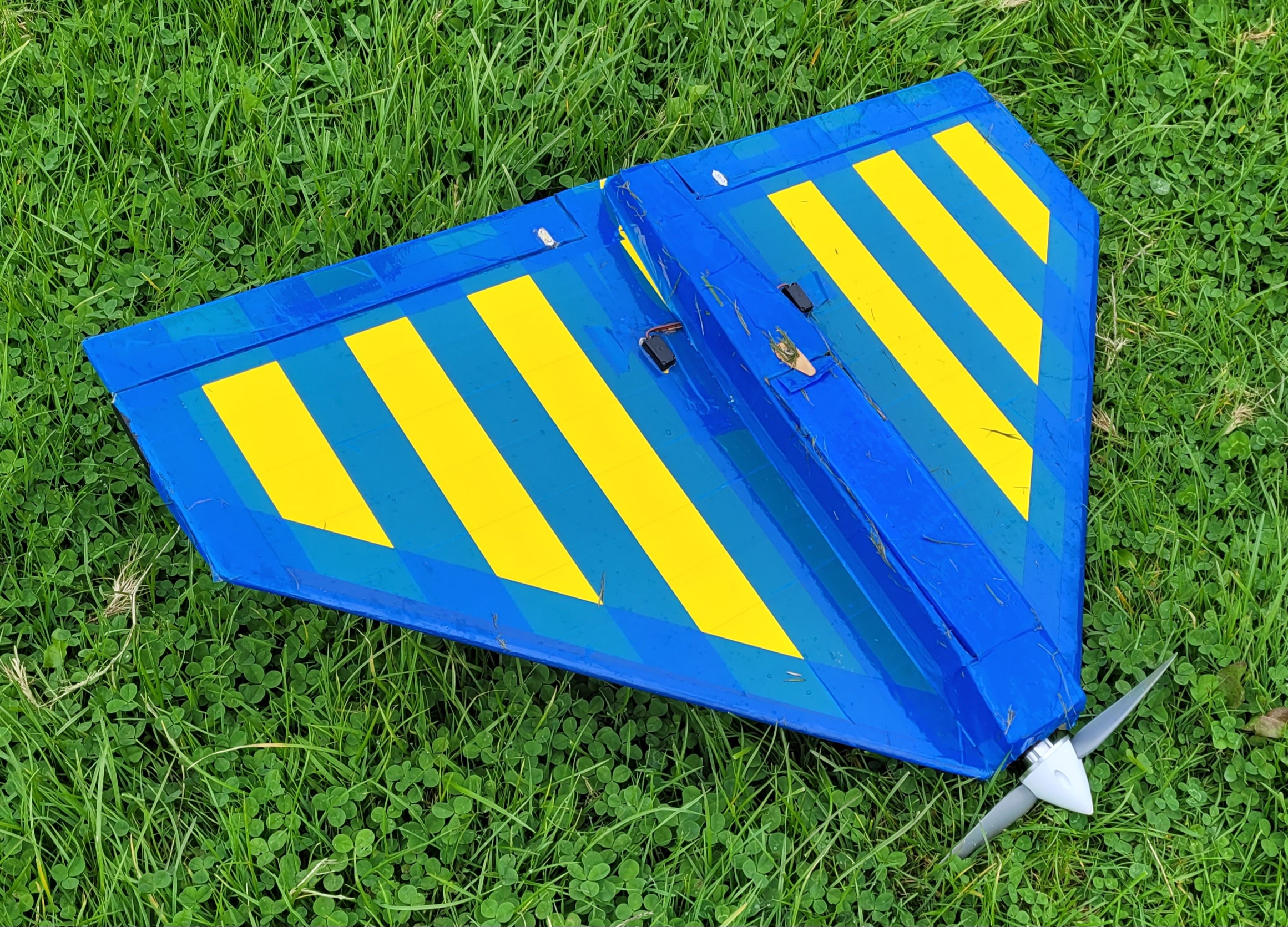 It flies very well, slower than previously of course which is just what Woody wanted and, as you can see in the video, is an excellent, steady flier. It’s good to see it back in use again.
Sticking with Woody, he had a bit of a mishap with his foamboard Typhoon in October.
He was flying it really well and did a lovely low pass over the patch, pulled up vertically, and promptly stalled! The Typhoon’s fall was halted by a large bush alongside the track.
It flies very well, slower than previously of course which is just what Woody wanted and, as you can see in the video, is an excellent, steady flier. It’s good to see it back in use again.
Sticking with Woody, he had a bit of a mishap with his foamboard Typhoon in October.
He was flying it really well and did a lovely low pass over the patch, pulled up vertically, and promptly stalled! The Typhoon’s fall was halted by a large bush alongside the track. 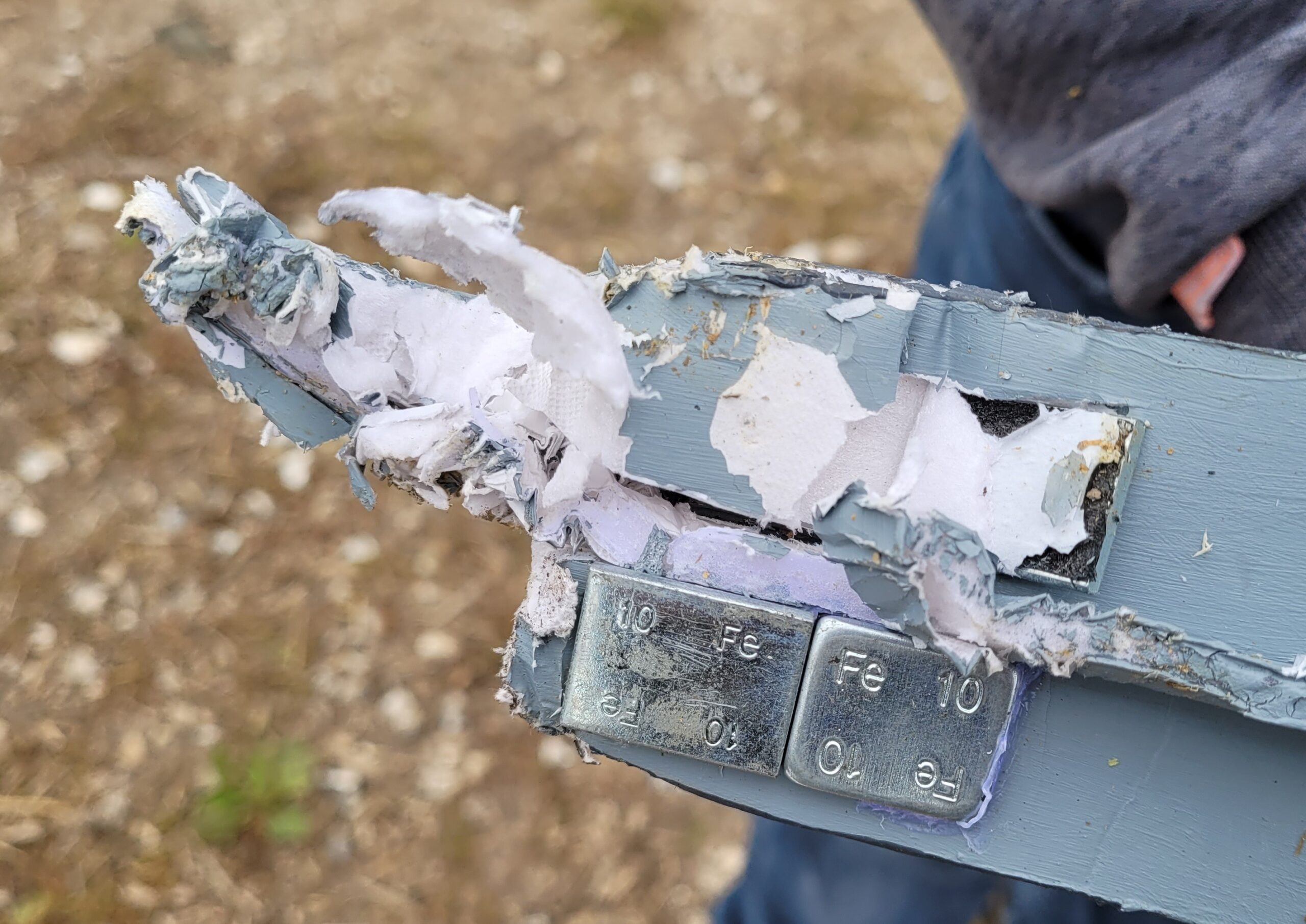
 Fortunately, the damage was not too bad, less fortunately (for us) although I was filming at the time I missed the bush entry! Here’s a couple of screenshots from the video I took.
Fortunately, the damage was not too bad, less fortunately (for us) although I was filming at the time I missed the bush entry! Here’s a couple of screenshots from the video I took.
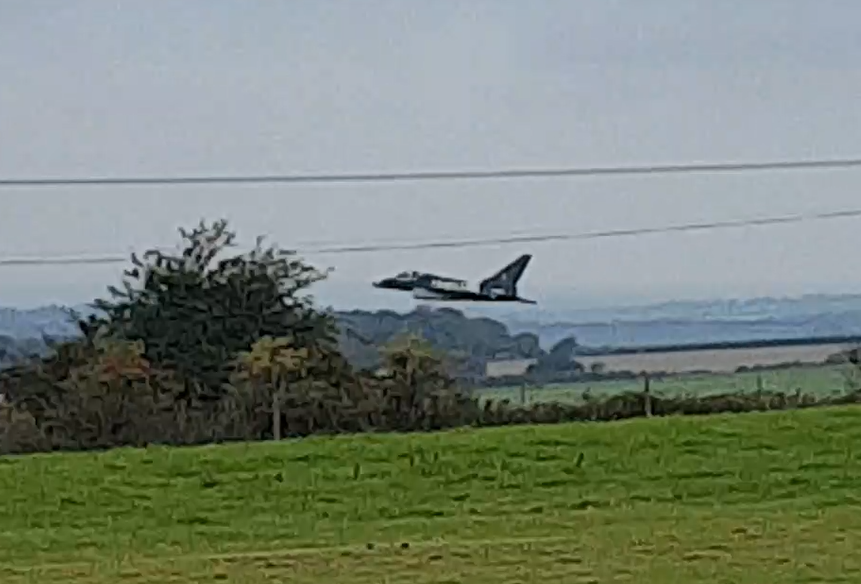
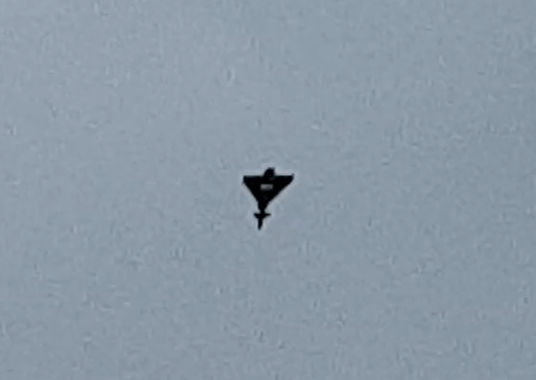 Not wishing to hurt Woody’s feelings I haven’t included the Moggie mishap in this month’s video, instead I have included Woody flying his foamboard F-16 with rather more success!
At one flying session in October I was flying my FMS Futura but was struggling to take-off with the slightly long grass wet with autumn dew and eventually I snapped the nose-leg.
Not wishing to hurt Woody’s feelings I haven’t included the Moggie mishap in this month’s video, instead I have included Woody flying his foamboard F-16 with rather more success!
At one flying session in October I was flying my FMS Futura but was struggling to take-off with the slightly long grass wet with autumn dew and eventually I snapped the nose-leg.
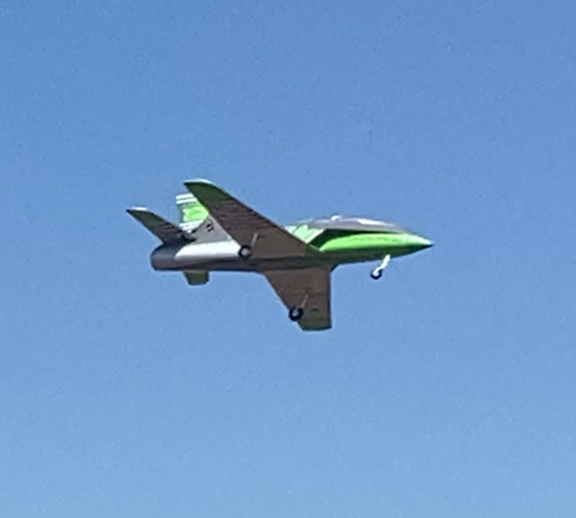 Although the EDF jets look nicer in the air with the undercarriage removed I had left mine on as I was rather enjoying landing on wheels and taxiing back, plus I was unsure how well the Futura would go from a hand launch. Having snapped the nose-leg it was time to find out so I removed the main undercarriage legs as well and asked 1066 to try launching it.
Although the EDF jets look nicer in the air with the undercarriage removed I had left mine on as I was rather enjoying landing on wheels and taxiing back, plus I was unsure how well the Futura would go from a hand launch. Having snapped the nose-leg it was time to find out so I removed the main undercarriage legs as well and asked 1066 to try launching it.
 No problems at all, it went away perfectly and had an increase in performance as well as looking better. While all this was going on 1066 mentioned that there was an Arrows Hobby Avanti for sale on Facebook for a sensible price and someone reckoned the seller was PAM member Page Boy. I have always liked the Avanti so I contacted Page Boy via WhatsApp and we discussed the Avanti between Futura flights. But during one flight there was a sudden bang as the Futura and John Warren’s Tasman clipped each other! John’s Tasman carried on flying perfectly but the Futura spun in, and on examination afterwards, it seems that one of the Tasman’s wheels had removed a large part of the Futura’s fin.
No problems at all, it went away perfectly and had an increase in performance as well as looking better. While all this was going on 1066 mentioned that there was an Arrows Hobby Avanti for sale on Facebook for a sensible price and someone reckoned the seller was PAM member Page Boy. I have always liked the Avanti so I contacted Page Boy via WhatsApp and we discussed the Avanti between Futura flights. But during one flight there was a sudden bang as the Futura and John Warren’s Tasman clipped each other! John’s Tasman carried on flying perfectly but the Futura spun in, and on examination afterwards, it seems that one of the Tasman’s wheels had removed a large part of the Futura’s fin. 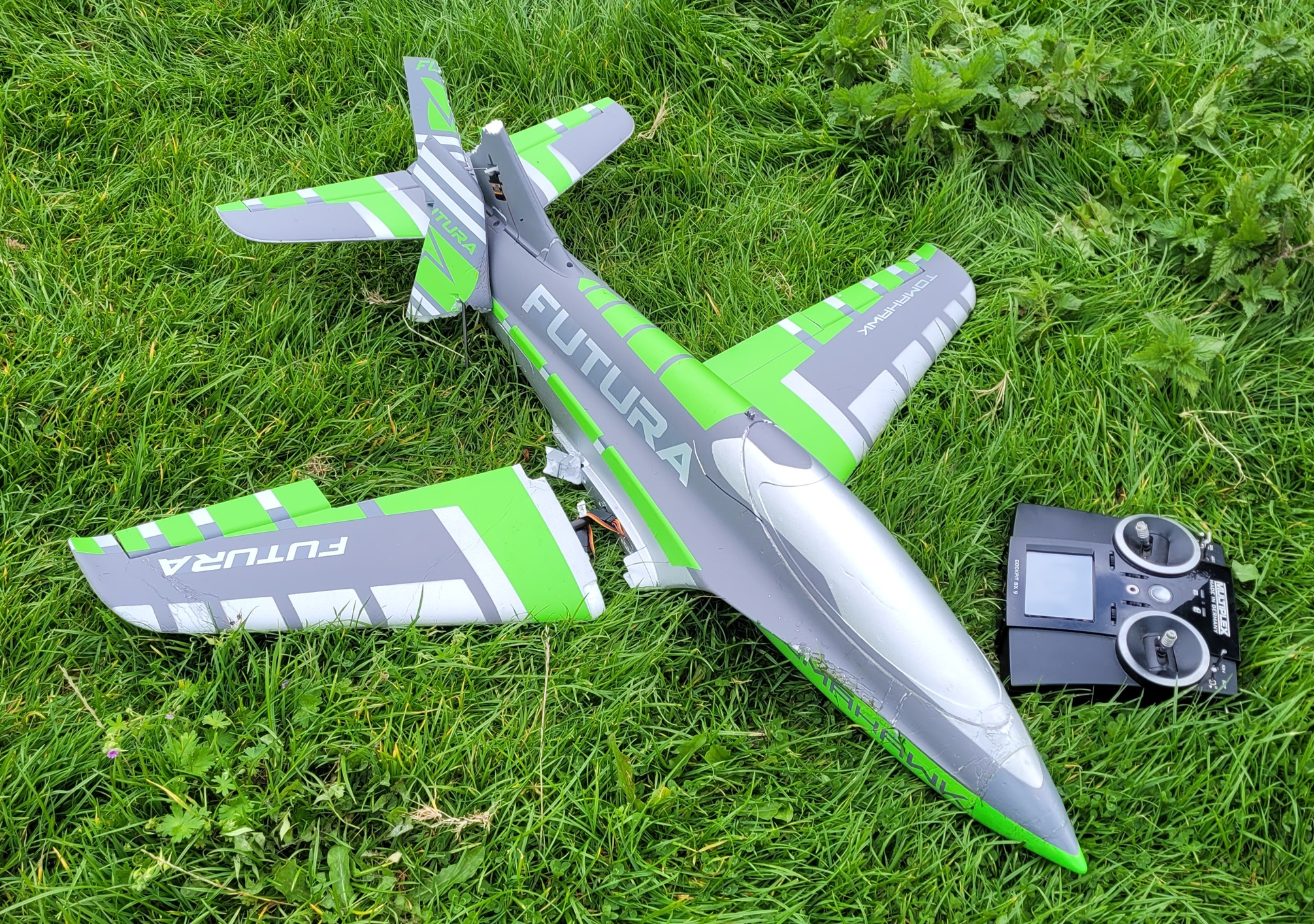 Fortunately, the Futura damage was not nearly as bad as I had expected and I will soon have it flying again. So then it was back to chatting with Page Boy as now I really needed the Avanti! The deal was done and Page Boy even delivered the plane to me that evening.
Fortunately, the Futura damage was not nearly as bad as I had expected and I will soon have it flying again. So then it was back to chatting with Page Boy as now I really needed the Avanti! The deal was done and Page Boy even delivered the plane to me that evening.

 Despite me featuring the Avanti in the March Patch News I had forgotten Page Boy even had one but he had only flown it two or three times as he is currently bogged down with other things and hasn’t been able to come flying. He decided to do a bit of a thinning out of his models and as the Avanti is in ‘as new’ condition he thought it would be an easy sell.
Despite me featuring the Avanti in the March Patch News I had forgotten Page Boy even had one but he had only flown it two or three times as he is currently bogged down with other things and hasn’t been able to come flying. He decided to do a bit of a thinning out of his models and as the Avanti is in ‘as new’ condition he thought it would be an easy sell.
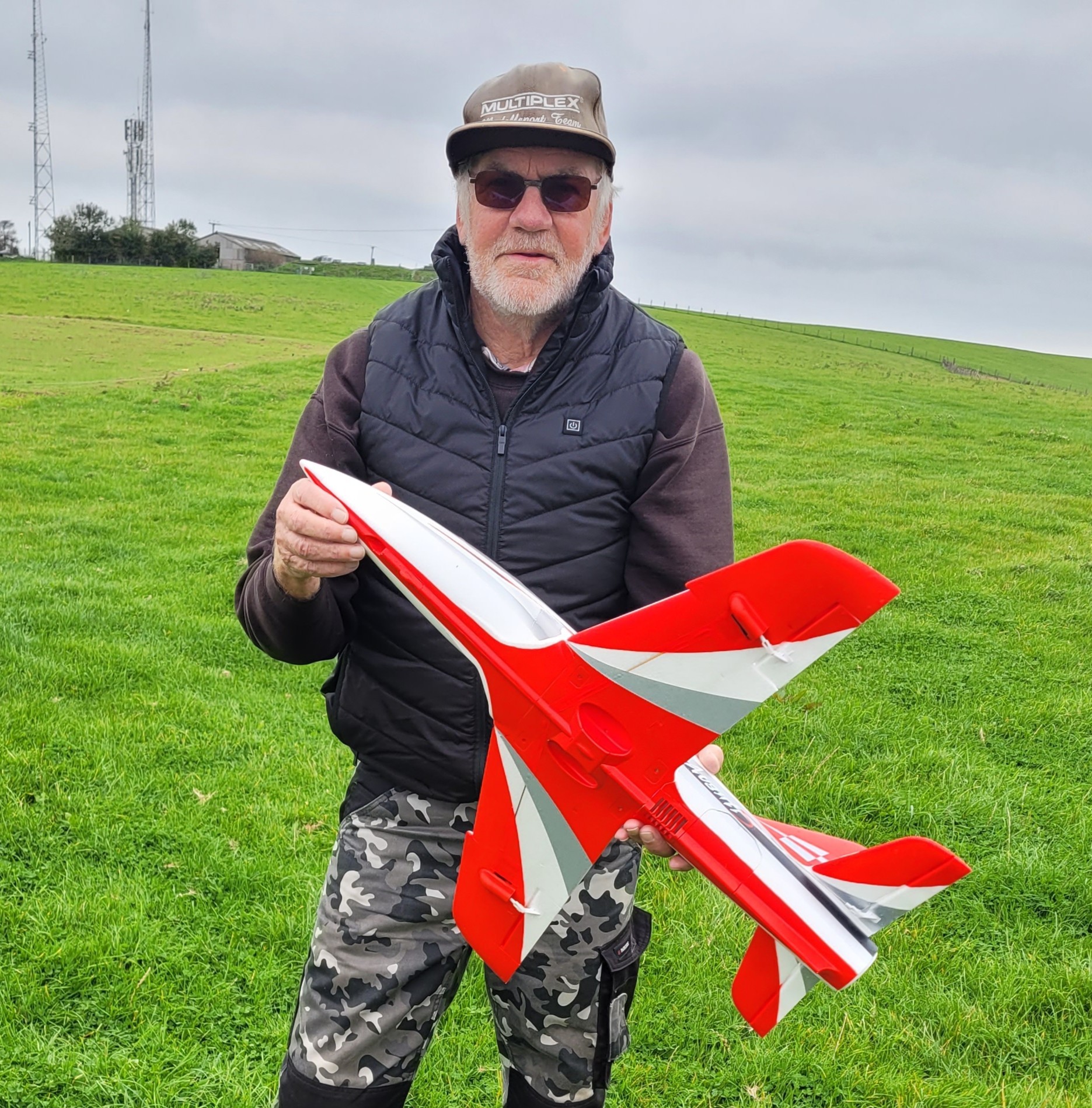 The EPO foam Avanti comes almost finished with an 11 blade fan, 2627 4500kv motor, 30A esc, 6 axis gyro, and 3 x 9g servos all pre-installed. All I had to do was replace Page Boy’s Spektrum receiver with a Multiplex one and it was ready for the next flying session.
The EPO foam Avanti comes almost finished with an 11 blade fan, 2627 4500kv motor, 30A esc, 6 axis gyro, and 3 x 9g servos all pre-installed. All I had to do was replace Page Boy’s Spektrum receiver with a Multiplex one and it was ready for the next flying session.
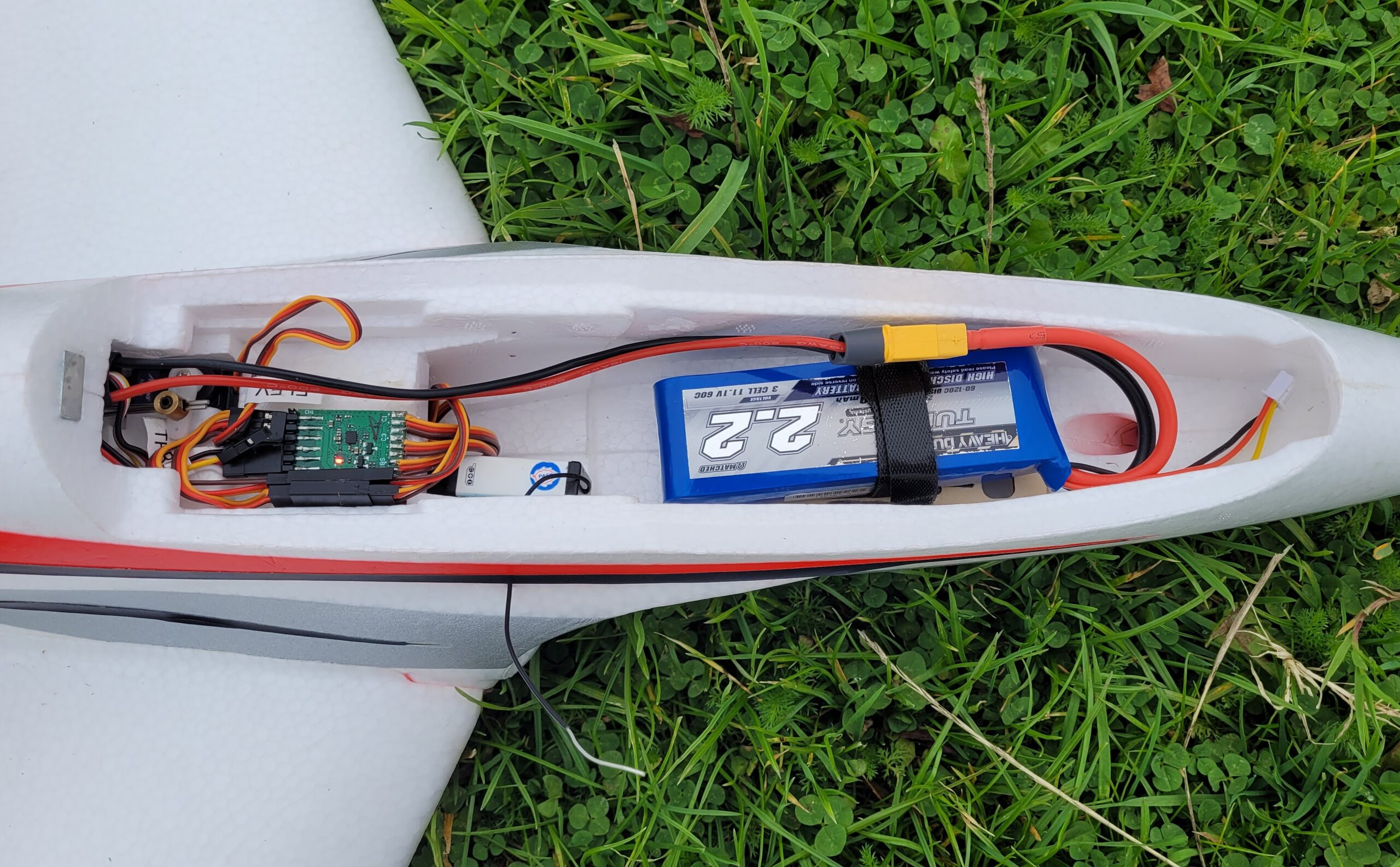 The specs say to use a three cell lipo with a capacity of 1300mAh to 16oomAh so of course I promptly fitted a 2200mAh pack! This is my first Arrows EDF so I had asked other club members what they use and most seem to use 2200mAh packs, hence my decision.
The specs say to use a three cell lipo with a capacity of 1300mAh to 16oomAh so of course I promptly fitted a 2200mAh pack! This is my first Arrows EDF so I had asked other club members what they use and most seem to use 2200mAh packs, hence my decision.
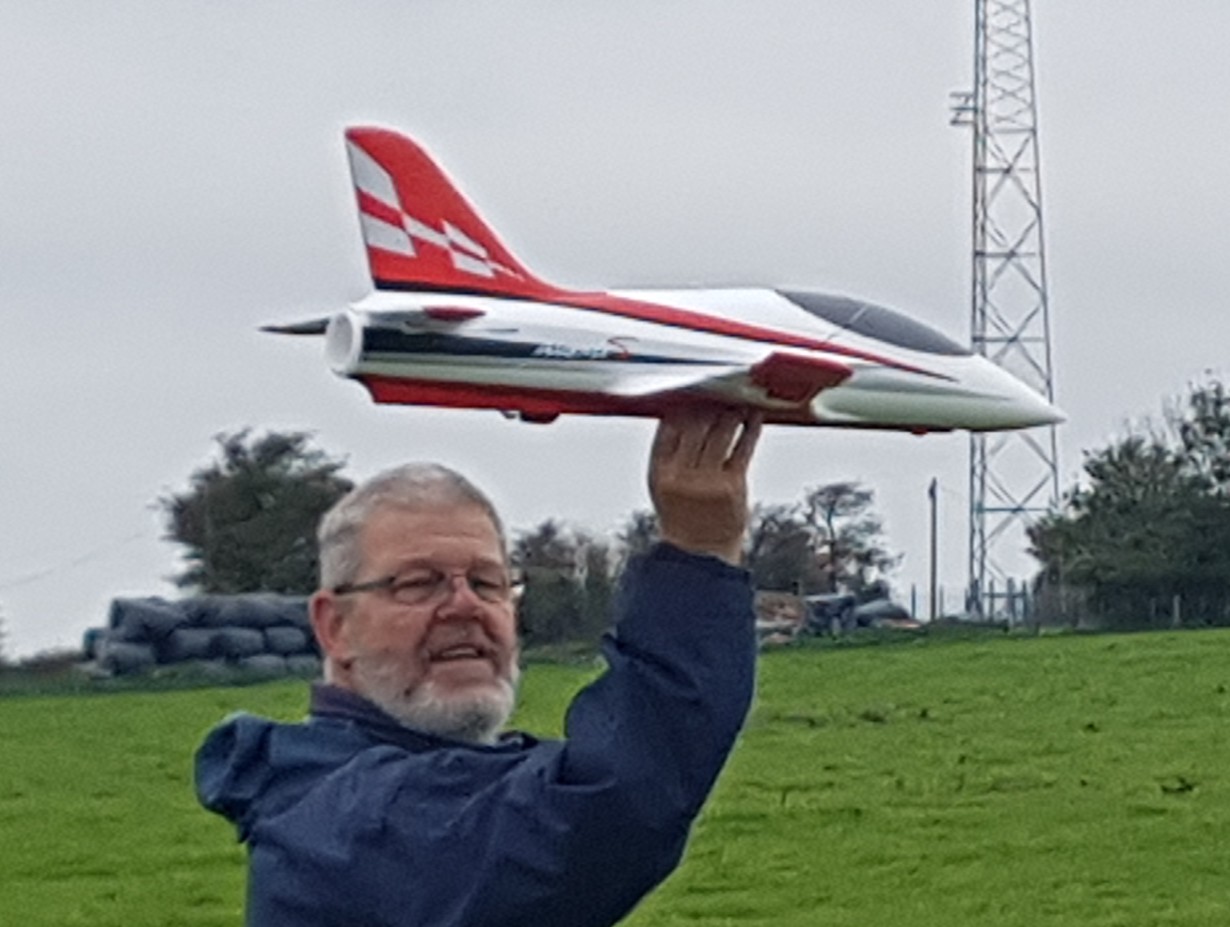 1066 gave it a chuck and I’m happy to report that it flies beautifully. It’s slightly nose heavy with the 2200mAh lipo but it’s fine. You can see the Avanti flying in this month’s video.
Mini Mike’s latest E-flite Electro Streak flies extremely well, and he has proved that it will reach 125mph. 1066 got jealous and decided that he wanted some of that action so he set about building an Electro Streak from the long discontinued Great Planes kit.
1066 gave it a chuck and I’m happy to report that it flies beautifully. It’s slightly nose heavy with the 2200mAh lipo but it’s fine. You can see the Avanti flying in this month’s video.
Mini Mike’s latest E-flite Electro Streak flies extremely well, and he has proved that it will reach 125mph. 1066 got jealous and decided that he wanted some of that action so he set about building an Electro Streak from the long discontinued Great Planes kit.
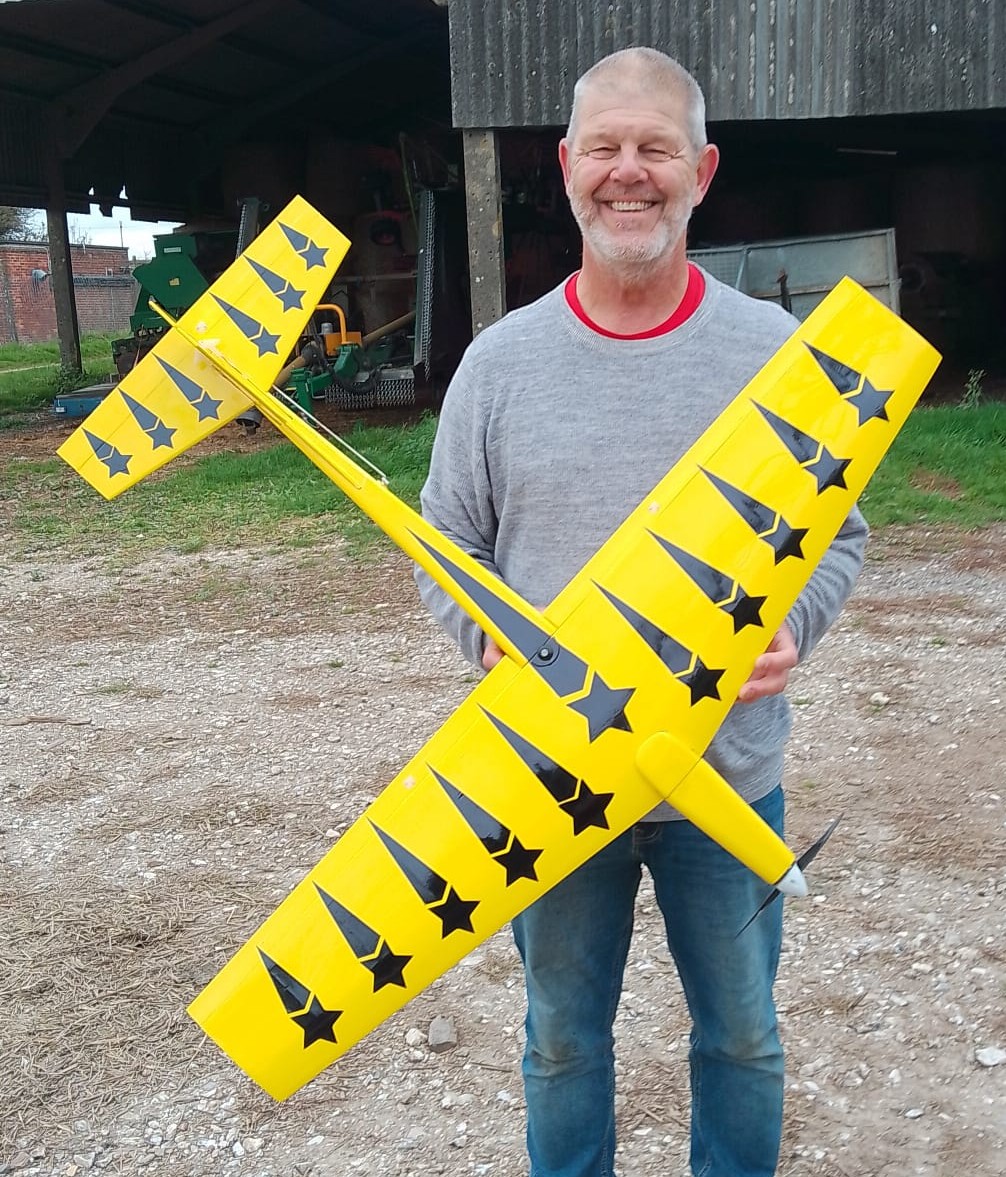 I pictured it last month, built but awaiting it’s covering, and it’s now finished and flying.
I pictured it last month, built but awaiting it’s covering, and it’s now finished and flying.
 Here’s a little of the Electro Streak history that I gleaned from the Outer Zone website:
The Electro Streak was originally designed by Tom Stryker and featured in November 1987 Model Aviation… it was kitted the next year by Great Planes. A 44 in span aerobatic model designed for 550 motors and 7 cells (Great Planes own Goldfire motor was included with the kit, the equivalent of a 7.2V speed 600 or the Simprop power speed 660) the Electro Streak is a fine exercise in minimal design, the lightweight air-frame offsetting the heavy motors and batteries of the day to give excellent performance.
Here’s a little of the Electro Streak history that I gleaned from the Outer Zone website:
The Electro Streak was originally designed by Tom Stryker and featured in November 1987 Model Aviation… it was kitted the next year by Great Planes. A 44 in span aerobatic model designed for 550 motors and 7 cells (Great Planes own Goldfire motor was included with the kit, the equivalent of a 7.2V speed 600 or the Simprop power speed 660) the Electro Streak is a fine exercise in minimal design, the lightweight air-frame offsetting the heavy motors and batteries of the day to give excellent performance.
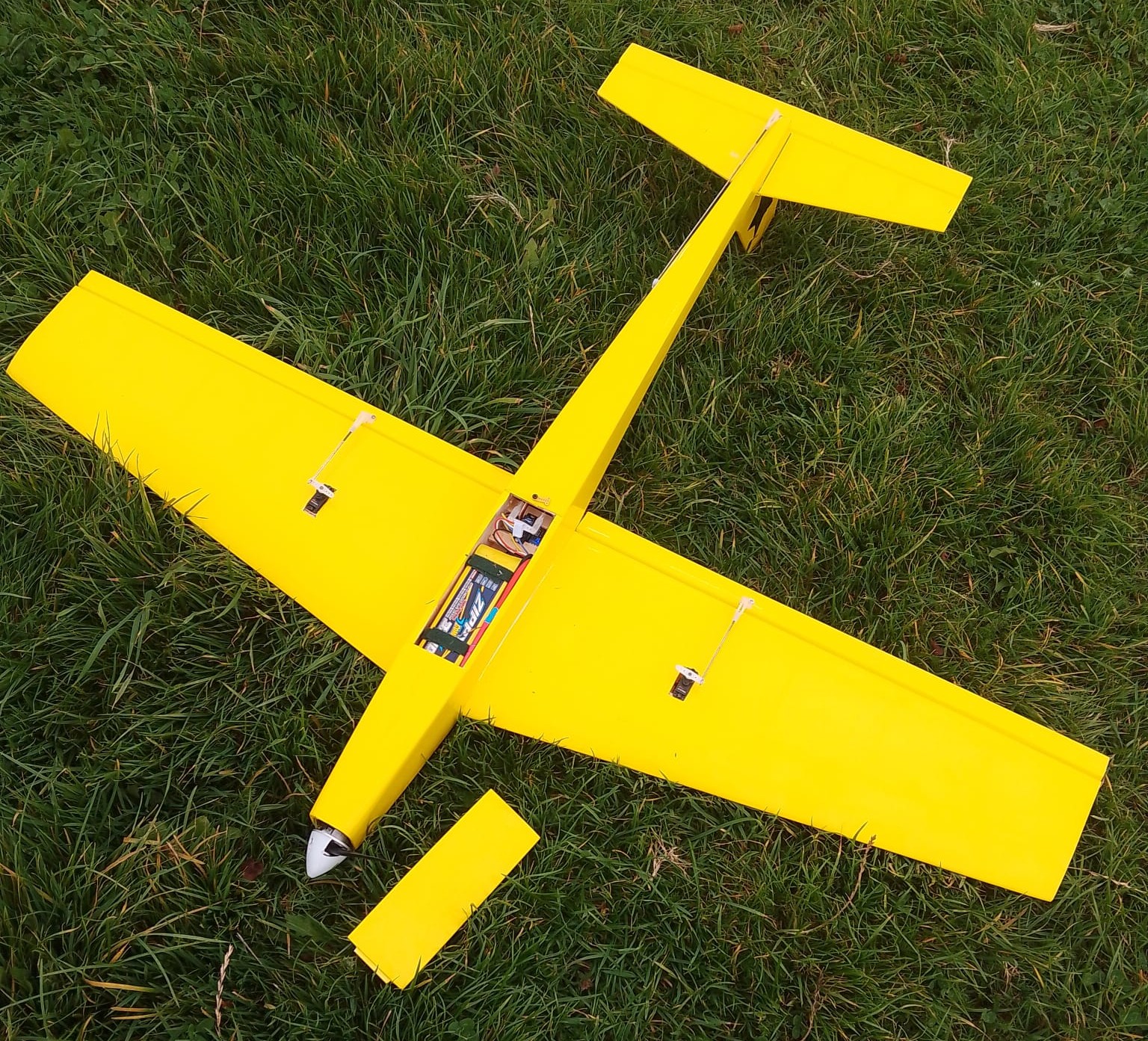
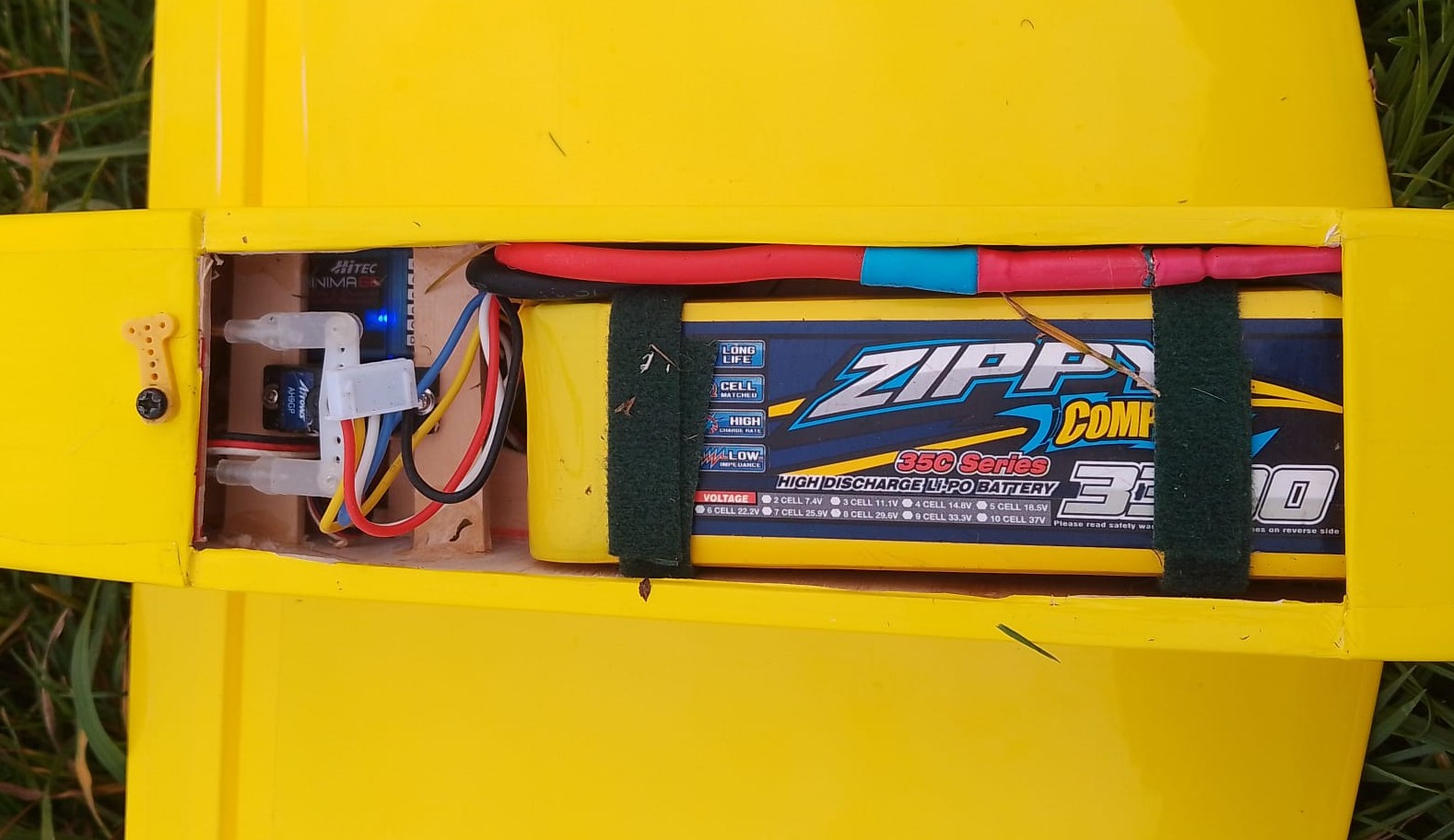 Things have moved on a lot since 1987 of course and we now use brushless motors and lipo batteries. In his Electro Streak 1066 is using four cell 3300mAh packs for power.
Things have moved on a lot since 1987 of course and we now use brushless motors and lipo batteries. In his Electro Streak 1066 is using four cell 3300mAh packs for power.
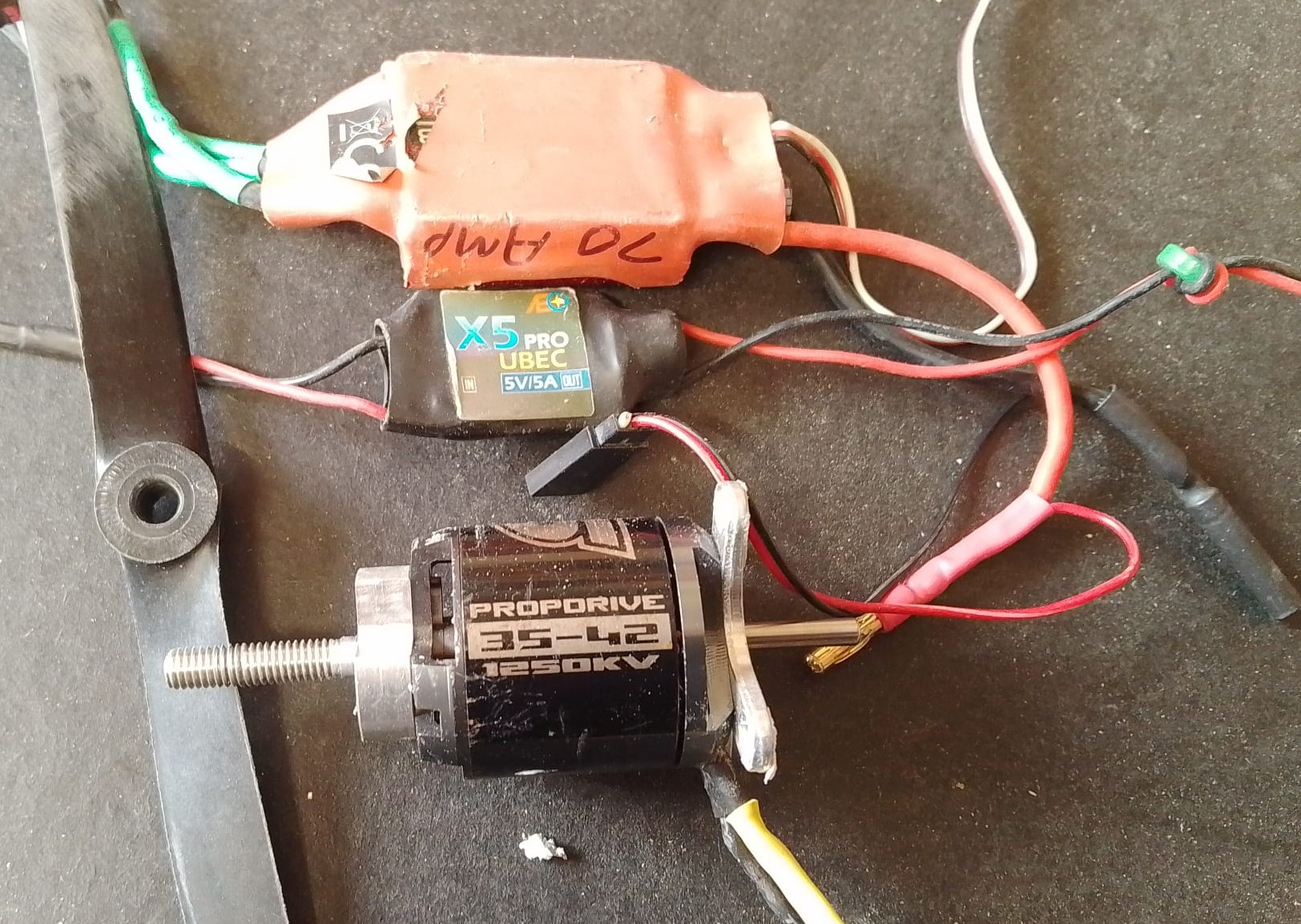
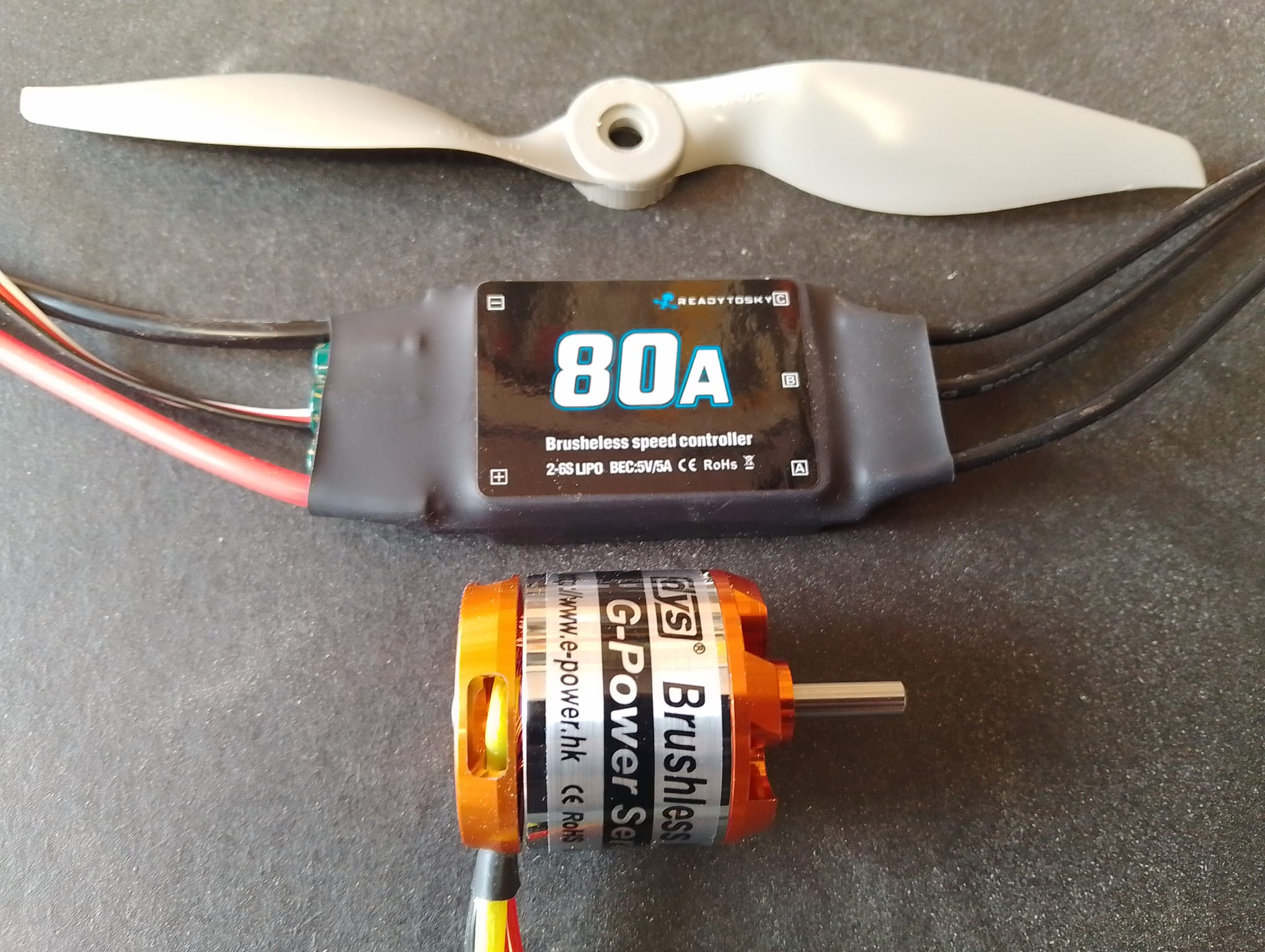 For the first flights 1066 fitted an old Propdrive 3542 1250KV motor along with a 70A speed controller, but has since changed to an E-Power D3542 1450KV motor and an 80A speed controller. He says he’s not sure that there is much more power but it certainly sounds better. You can see it flying in this month’s video with the Propdrive motor and it appears to have reasonable speed and plenty of power for vertical climbs but the motor does sound a bit rough. If you fancy building an Electro Streak for yourself you can find out more and download the free plan from the Outer Zone website by clicking HERE
This month the action shots are all ones that Kryten has taken over the last few years:
For the first flights 1066 fitted an old Propdrive 3542 1250KV motor along with a 70A speed controller, but has since changed to an E-Power D3542 1450KV motor and an 80A speed controller. He says he’s not sure that there is much more power but it certainly sounds better. You can see it flying in this month’s video with the Propdrive motor and it appears to have reasonable speed and plenty of power for vertical climbs but the motor does sound a bit rough. If you fancy building an Electro Streak for yourself you can find out more and download the free plan from the Outer Zone website by clicking HERE
This month the action shots are all ones that Kryten has taken over the last few years: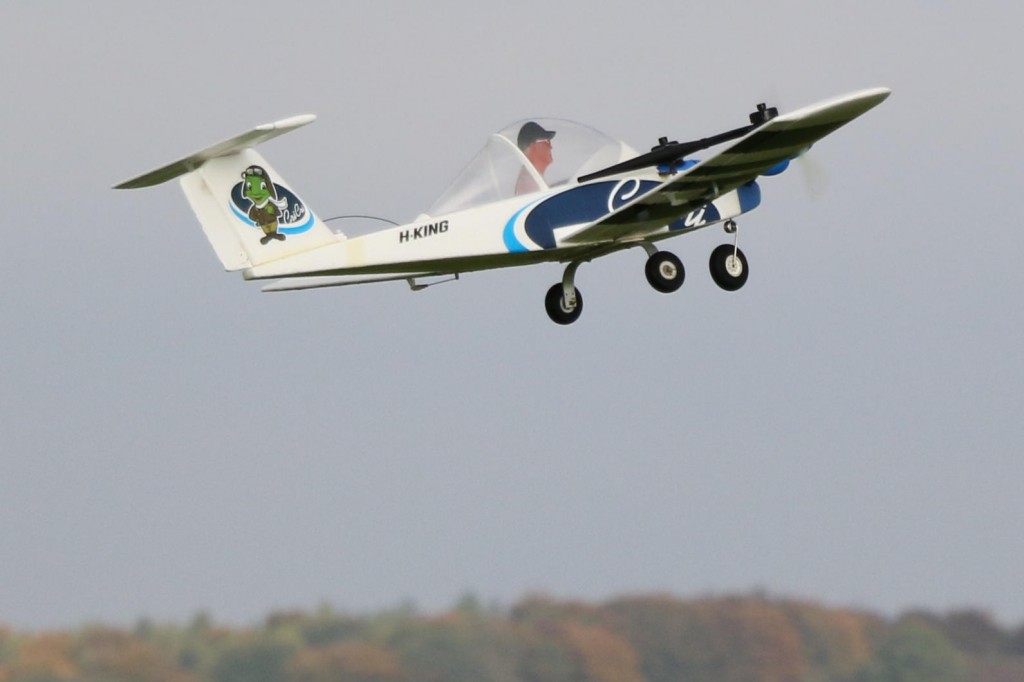
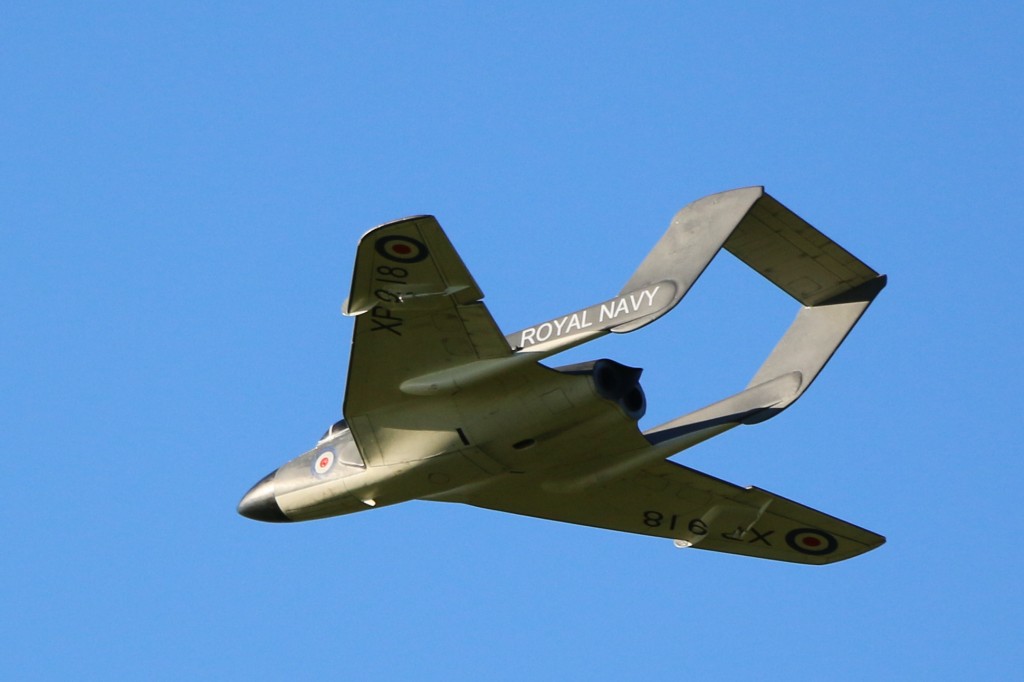
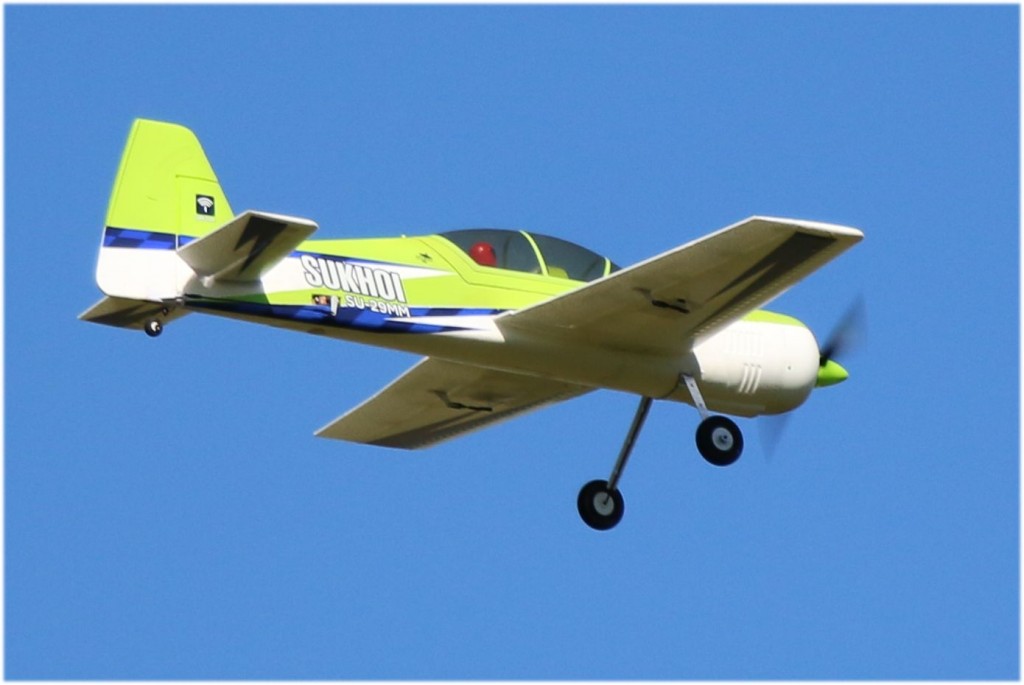
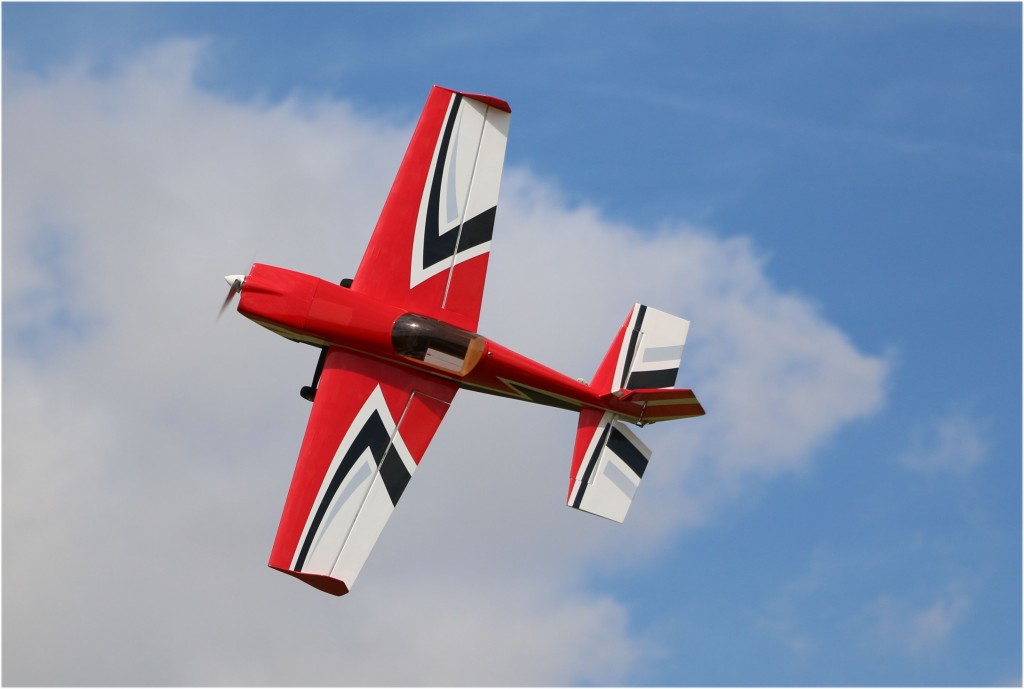
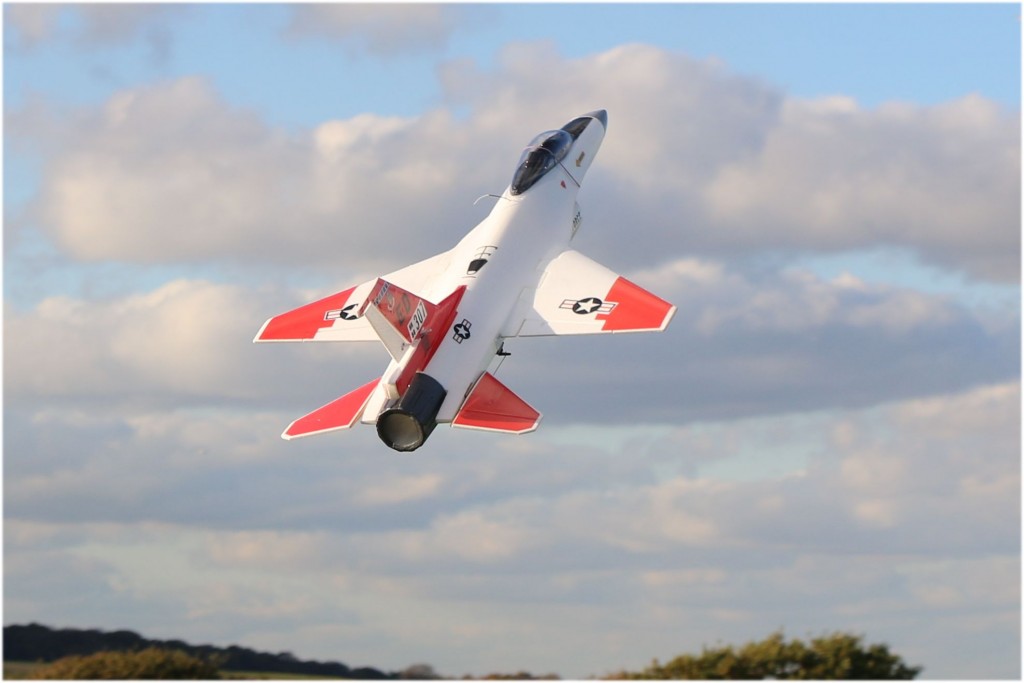
 >
This month’s video is a little different as I’ve made it with Microsoft Clipchamp rather than the old Windows Movie Maker that I’d always used previously. Movie Maker was originally released in September 2000(!) and was officially discontinued by Microsoft in January 2017 so it’s not really surprising that I was having lots of problems and crashes running it on Windows 11 in 2025. I was reluctant to change as I’d grown to know Movie Maker really well over the years and it had all the basic editing functions that I needed. But it ran very slowly and I had to save my work every few minutes under two different filenames as I knew it would randomly crash and I’d lose whichever filename I was on at the time.
>
This month’s video is a little different as I’ve made it with Microsoft Clipchamp rather than the old Windows Movie Maker that I’d always used previously. Movie Maker was originally released in September 2000(!) and was officially discontinued by Microsoft in January 2017 so it’s not really surprising that I was having lots of problems and crashes running it on Windows 11 in 2025. I was reluctant to change as I’d grown to know Movie Maker really well over the years and it had all the basic editing functions that I needed. But it ran very slowly and I had to save my work every few minutes under two different filenames as I knew it would randomly crash and I’d lose whichever filename I was on at the time.
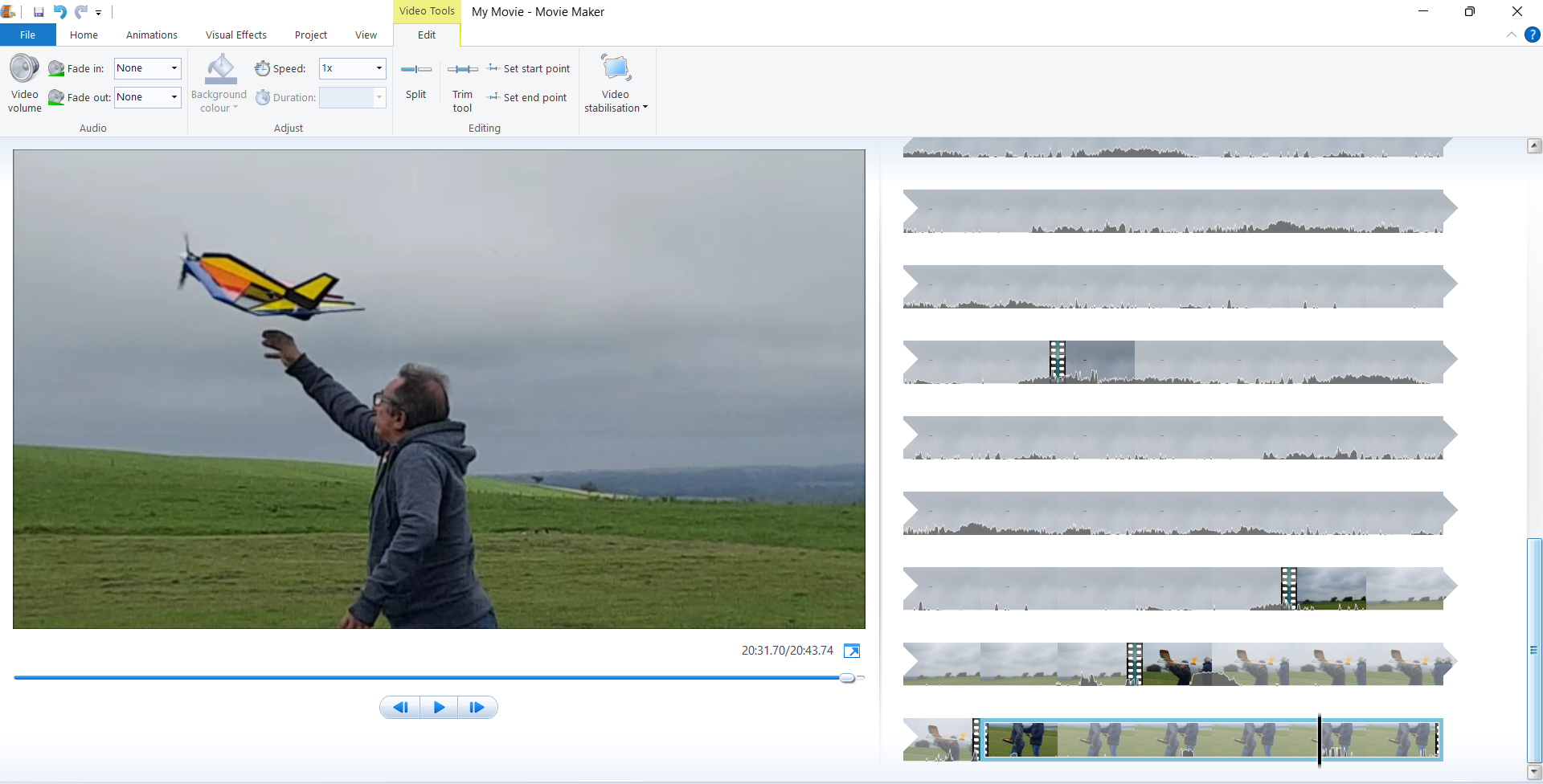 I discussed the problem with my son who understands these things and he talked about 32-bit/64-bit etc and suggested I try Clipchamp. So I bit the bullet and after an awful lot of faffing about I seem to have got the hang of it, and it did not lock up or crash once.
I discussed the problem with my son who understands these things and he talked about 32-bit/64-bit etc and suggested I try Clipchamp. So I bit the bullet and after an awful lot of faffing about I seem to have got the hang of it, and it did not lock up or crash once.
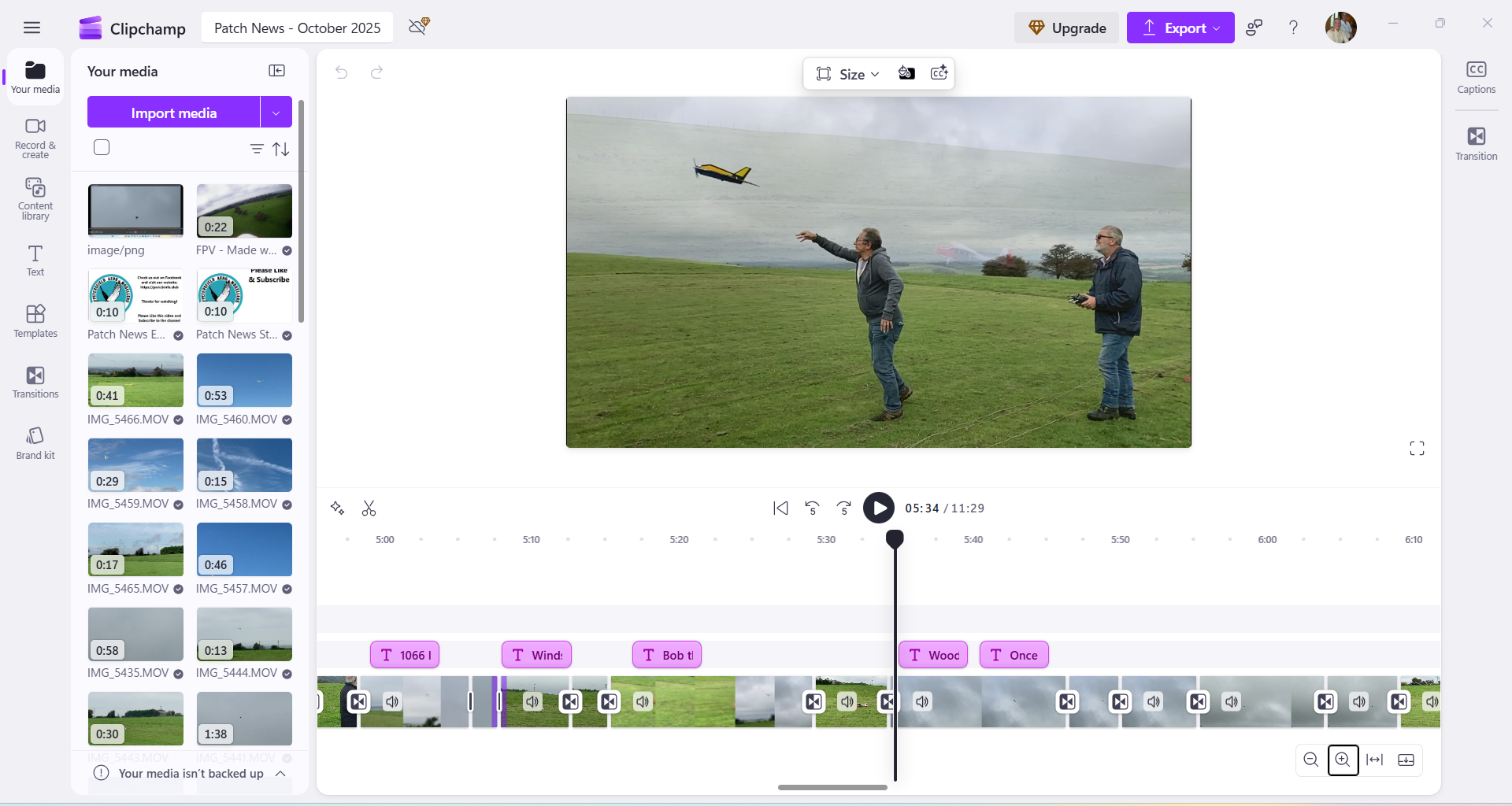 I don’t think any of you will notice anything very different in the video, I’ve tried to make it much the same as before but there will be a few small differences. This month the clips were filmed by me, MacFly, Dougal, and Captain Slow, thanks for all your efforts guys.
Please watch the video full-screen, it’s so much better with small models flying around:
If the video won’t play for you please click HERE
The Final Funny:
For homework, a teacher told his students to ask their parents for a story with a moral. The next day, each of the kids told their stories, until only one little girl, Katie, was left.
“Katie, did your parents tell you a story with a moral?” asked the teacher.
‘Yes Sir…my mum told me a story about my dad.”
“OK Katie, go ahead, let’s hear the story then.” said the teacher.
“Well, my dad was an RAF pilot in Iraq and his plane got hit by enemy fire.”
“He had to bail out over enemy territory and all he had was a bottle of whisky, a pistol, and a survival knife. He drank the whisky on the way down in case the bottle broke, and then his parachute landed him right in the middle of twenty enemy fighters.”
“He shot fifteen of them with the pistol but then he ran out of bullets. He killed four more with the knife, then the blade broke, and then he killed the last one with his bare hands.”
”OMG!” said the horrified teacher. “What did your mum say was the moral of this?”
“Stay away from Daddy when he’s drunk!!!”
Colin Cowplain
I don’t think any of you will notice anything very different in the video, I’ve tried to make it much the same as before but there will be a few small differences. This month the clips were filmed by me, MacFly, Dougal, and Captain Slow, thanks for all your efforts guys.
Please watch the video full-screen, it’s so much better with small models flying around:
If the video won’t play for you please click HERE
The Final Funny:
For homework, a teacher told his students to ask their parents for a story with a moral. The next day, each of the kids told their stories, until only one little girl, Katie, was left.
“Katie, did your parents tell you a story with a moral?” asked the teacher.
‘Yes Sir…my mum told me a story about my dad.”
“OK Katie, go ahead, let’s hear the story then.” said the teacher.
“Well, my dad was an RAF pilot in Iraq and his plane got hit by enemy fire.”
“He had to bail out over enemy territory and all he had was a bottle of whisky, a pistol, and a survival knife. He drank the whisky on the way down in case the bottle broke, and then his parachute landed him right in the middle of twenty enemy fighters.”
“He shot fifteen of them with the pistol but then he ran out of bullets. He killed four more with the knife, then the blade broke, and then he killed the last one with his bare hands.”
”OMG!” said the horrified teacher. “What did your mum say was the moral of this?”
“Stay away from Daddy when he’s drunk!!!”
Colin Cowplain Patch News – September 2025
I was away for two weeks near the start of the month and from what I hear most of what I missed was rain. The UK summer had been incredibly dry with record lows of rainfall so I suppose more rain than usual in September was not unexpected. Since I returned the weather had been good, many days have been dry with lots of clear skies and sunshine, but rain stopped play on the last Sunday of the month so it was time for beverages in the barn.

 It’s now officially autumn so, as we head towards winter, our flying opportunities will decrease but no doubt many PAM members will still make the effort to fly regularly.
It’s now officially autumn so, as we head towards winter, our flying opportunities will decrease but no doubt many PAM members will still make the effort to fly regularly.
With the rain, the grass greened up nicely but of course it also grew a lot. As the patch grass became too long for many models Woody and 1066 took it upon themselves to go up one morning to mow and found it took two cuts as it had grown so long. Cutting the entire patch twice is a lot of work for two people and is something that we must ensure doesn’t need doing again. Huge thanks to them both for the hard work, we are very grateful.
There seems to have been a lack of new models flown in September, the only completely new model I spotted was Woody’s foamboard F-16 Fighting Falcon that he’s decorated very nicely in the colour scheme of the USAF Thunderbirds aerobatic team.
 The model was built from a plan published on rc.tomhe.net, a site that has plans for several similar foamboard models including the Eurofighter Typhoon that Woody has already built and which flies very well. The F-16 has a wingspan of 720mm, is 1180mm long, and Woody has fitted a 2212 2450KV motor controlled by a 40A speed controller. The F-16 differs from most of the foamboards that have been built by club members in that it has a rear mounted pusher motor rather than the usual mid-mounted motor. For Woody the F-16 has been a very radical departure from his usual builds, no, not because of the rear mounted motor, but because on this one he hasn’t fitted any lights, not a single one!
The model was built from a plan published on rc.tomhe.net, a site that has plans for several similar foamboard models including the Eurofighter Typhoon that Woody has already built and which flies very well. The F-16 has a wingspan of 720mm, is 1180mm long, and Woody has fitted a 2212 2450KV motor controlled by a 40A speed controller. The F-16 differs from most of the foamboards that have been built by club members in that it has a rear mounted pusher motor rather than the usual mid-mounted motor. For Woody the F-16 has been a very radical departure from his usual builds, no, not because of the rear mounted motor, but because on this one he hasn’t fitted any lights, not a single one!
 The original construction is for the model to be built from Depron but, as is much more usual for PAM members, Woody has built his using Hobbycraft foamboard. This is 5mm thick and consists of a dense foam core sandwiched between sheets of white paper and comes in A1 size (841mmx594mm). At just £12 for four sheets it’s a very economical building material. If required the paper can be removed by soaking in warm water which has the advantage of making the board lighter (but also weaker) but this also highlights a problem. If the paper covering is left in place there’s a tendency for it to lift if the model is left on wet grass for too long, a waterproof mat is required! As the Thunderbirds colour scheme is largely white Woody has left the paper in place but has taped the cut edges of the board to seal them and hopefully prevent any peeling. The designer says that the F-16 can be flown using tailerons only but the ailerons are also marked on the plan and Woody originally built his with two servos, with each servo driving one elevator and one aileron.
The original construction is for the model to be built from Depron but, as is much more usual for PAM members, Woody has built his using Hobbycraft foamboard. This is 5mm thick and consists of a dense foam core sandwiched between sheets of white paper and comes in A1 size (841mmx594mm). At just £12 for four sheets it’s a very economical building material. If required the paper can be removed by soaking in warm water which has the advantage of making the board lighter (but also weaker) but this also highlights a problem. If the paper covering is left in place there’s a tendency for it to lift if the model is left on wet grass for too long, a waterproof mat is required! As the Thunderbirds colour scheme is largely white Woody has left the paper in place but has taped the cut edges of the board to seal them and hopefully prevent any peeling. The designer says that the F-16 can be flown using tailerons only but the ailerons are also marked on the plan and Woody originally built his with two servos, with each servo driving one elevator and one aileron.
 This seems a strange set-up but lots of foamboard models use this method and it works well. Unfortunately, in a rush to finish the plane, Woody’s linkages weren’t running freely enough and we didn’t want to risk a test flight with them like that. After a general discussion the consensus amongst those present was to disconnect the ailerons and rely solely on the tailerons, something that Woody was able to do at the field.
This seems a strange set-up but lots of foamboard models use this method and it works well. Unfortunately, in a rush to finish the plane, Woody’s linkages weren’t running freely enough and we didn’t want to risk a test flight with them like that. After a general discussion the consensus amongst those present was to disconnect the ailerons and rely solely on the tailerons, something that Woody was able to do at the field.
 The first flight attempt showed there wasn’t enough movement so changes were made. The next try was much better and the F-16 flew reasonably well for a couple of minutes. After more adjustments the third flight was much more successful and the plane flew well and looked good in the air but needed more roll control, so Woody took it home and added two servos and aileron linkages so it now has separate controls for the elevators and ailerons.
The first flight attempt showed there wasn’t enough movement so changes were made. The next try was much better and the F-16 flew reasonably well for a couple of minutes. After more adjustments the third flight was much more successful and the plane flew well and looked good in the air but needed more roll control, so Woody took it home and added two servos and aileron linkages so it now has separate controls for the elevators and ailerons.
 Next time out the F-16 flew beautifully, a great improvement and fully under control. Dougal filmed the first three flights goes so you can see them in this month’s video. At the moment I don’t have any footage of it flying with the ailerons connected, hopefully I can include some next month. Well done Woody, after a few hiccups Thunderbirds Are Go! Yes, I know that expression was the puppet Thunderbirds not the aerobatic team but…!
Next time out the F-16 flew beautifully, a great improvement and fully under control. Dougal filmed the first three flights goes so you can see them in this month’s video. At the moment I don’t have any footage of it flying with the ailerons connected, hopefully I can include some next month. Well done Woody, after a few hiccups Thunderbirds Are Go! Yes, I know that expression was the puppet Thunderbirds not the aerobatic team but…!
Sticking with TV for a minute, here’s a Star Trek quote: It’s building Jim, but not as we know it… it’s 1066 building a building board. Following his build of the twisted Blink that featured last month 1066 realised that he needed a building board that was actually flat:
My wife has never been in our loft, but is adamant she knows everything that is up there so I often find myself crawling around, looking for things that have been thrown away years ago. On one such occasion recently I came across a large piece of chipboard, and an old piece of flat pack furniture which must have been there since we moved in, some 26 years ago. You’re probably thinking, what has this got to do with toy planes? Well, with my newly discovered enjoyment of building, I had been thinking of making a building board for some time, so, by chance I had found some of the material needed.
 The construction was straightforward, the sheet material from the loft was squared up leaving as much useable area as possible, the frame and cross bracing (parts from an old airing cupboard shelf I was given) was then glued and screwed to the chipboard.
The construction was straightforward, the sheet material from the loft was squared up leaving as much useable area as possible, the frame and cross bracing (parts from an old airing cupboard shelf I was given) was then glued and screwed to the chipboard.
Because the chipboard was not moisture resistant, and because it will be stored in the garage, all the internal parts were coated with some old varnish.
 The piece of Conti board (that’s Melamine faced chipboard to us non-woodworkers) was left slightly longer and screwed to the framework, this would be the bottom of the board and also create the bottom of a small trough at one end. I took a lot of care to make a flat building surface, clamping the board down when gluing and screwing, however when it was all dry, and I put it on the bench, building surface face down, the whole thing was rocking, very disappointing. Further investigation found the chipboard had got wet at some time in its life and had a swollen in the middle, something I hadn’t noticed.
The piece of Conti board (that’s Melamine faced chipboard to us non-woodworkers) was left slightly longer and screwed to the framework, this would be the bottom of the board and also create the bottom of a small trough at one end. I took a lot of care to make a flat building surface, clamping the board down when gluing and screwing, however when it was all dry, and I put it on the bench, building surface face down, the whole thing was rocking, very disappointing. Further investigation found the chipboard had got wet at some time in its life and had a swollen in the middle, something I hadn’t noticed.  Fortunately the fix was straightforward utilising a belt sander and spirit levels. The trough at the end is used to store my glue bottle, and it’s also very handy for catching offcuts of balsa etc. Up to now I hadn’t spent any money, but I needed something on the building surface able to take a pin, traditionally this would be cork, but that would mean spending money! So I eventually used some Hobbycraft art card that I already had, so still no money spent :-). Next, a small piece of sacrificial ply was added to use as a cutting area, this is only pinned on, so it can easily be replaced as and when necessary.
Fortunately the fix was straightforward utilising a belt sander and spirit levels. The trough at the end is used to store my glue bottle, and it’s also very handy for catching offcuts of balsa etc. Up to now I hadn’t spent any money, but I needed something on the building surface able to take a pin, traditionally this would be cork, but that would mean spending money! So I eventually used some Hobbycraft art card that I already had, so still no money spent :-). Next, a small piece of sacrificial ply was added to use as a cutting area, this is only pinned on, so it can easily be replaced as and when necessary.

 Finally, a handle was made from an old handbag shoulder strap, so it will be easier to carry indoors to continue building when it’s too cold out in the shed. I get a lot of pleasure making things from stuff that would often have been thrown away and, as I mentioned at the start, some of the materials used will be over 26 years old. They have now been used to make something that should be flat and useable long after I’m gone.
Finally, a handle was made from an old handbag shoulder strap, so it will be easier to carry indoors to continue building when it’s too cold out in the shed. I get a lot of pleasure making things from stuff that would often have been thrown away and, as I mentioned at the start, some of the materials used will be over 26 years old. They have now been used to make something that should be flat and useable long after I’m gone.
 Having built the board 1066 thought he’d better build a plane, so here’s a preview of his latest model, an Electro Streak that he’s building from the Great Planes discontinued kit.
Having built the board 1066 thought he’d better build a plane, so here’s a preview of his latest model, an Electro Streak that he’s building from the Great Planes discontinued kit.
It’s looking good so far, let’s hope it’s not twisted! More on the Electro Streak next month.
Mini Mike has repaired his Arrows Hobby Albatros after an ‘unexpected arrival’ last year.
 Fortunately he was able to purchase a new nose and it looks as good as new again now.
Fortunately he was able to purchase a new nose and it looks as good as new again now.
 Mike says the Albatros isn’t as nice to fly as either his Arrows Hawk or Avanti and thinks he needs to keep the speed up more than with the others but maybe he just needs a bit more stick time. It was a windy day when he flew it in early September which probably didn’t help and Mike has since found that that the gyro that came with the Albatros doesn’t seem to be working correctly so he’s removed it and will see how it handles without a gyro.
Mike says the Albatros isn’t as nice to fly as either his Arrows Hawk or Avanti and thinks he needs to keep the speed up more than with the others but maybe he just needs a bit more stick time. It was a windy day when he flew it in early September which probably didn’t help and Mike has since found that that the gyro that came with the Albatros doesn’t seem to be working correctly so he’s removed it and will see how it handles without a gyro.
It appeared to go well on three cells though he’s contemplating trying it on four cells.
One day at the end of August Dougal Entendre was flying his Durafly Rare Bear when it suddenly started making a rather nasty noise. Dougal got it down safely and discovered that the motor was obviously far from well, so there was no more flying that day.
 Back in the workshop he removed the 3536 1700kv motor, disassembled it, and discovered that at least two of the magnets had come loose. The Rare Bear is very fast when running the stock set-up of four cells with an 8×5 propeller but HobbyKing say that it can handle six cells if the propeller is swapped to a 6×4.5. As Dougal’s motor didn’t last for too many flights on the supplied set-up I would be wary of trying it on six cells. I reckon it’s plenty quick enough on four cells anyway, and Dougal tends to only go to full throttle for short bursts during a flight, but maybe that’s because we are all getting older!
Back in the workshop he removed the 3536 1700kv motor, disassembled it, and discovered that at least two of the magnets had come loose. The Rare Bear is very fast when running the stock set-up of four cells with an 8×5 propeller but HobbyKing say that it can handle six cells if the propeller is swapped to a 6×4.5. As Dougal’s motor didn’t last for too many flights on the supplied set-up I would be wary of trying it on six cells. I reckon it’s plenty quick enough on four cells anyway, and Dougal tends to only go to full throttle for short bursts during a flight, but maybe that’s because we are all getting older!
 This is what Dougal did to solve the problem: I re-motored my Rare Bear with a cheap 3536 1450kv unit that I found on eBay. The shaft is different from the old motor so I couldn’t use the spinner originally supplied, but at least you can see more of the dummy radial motor now! Plenty of torque, as I found out when I launched it with a little too much throttle. On the second flight I flick-rolled it fast enough for the canopy to fly off. I landed OK, and fortunately the canopy came down in our field. I am now trying to devise something a bit stronger than just the one magnet fixing. Dougal thinks it’s not quite as fast as before but it still looks crazily quick to me and it’s definitely a little quieter now.
This is what Dougal did to solve the problem: I re-motored my Rare Bear with a cheap 3536 1450kv unit that I found on eBay. The shaft is different from the old motor so I couldn’t use the spinner originally supplied, but at least you can see more of the dummy radial motor now! Plenty of torque, as I found out when I launched it with a little too much throttle. On the second flight I flick-rolled it fast enough for the canopy to fly off. I landed OK, and fortunately the canopy came down in our field. I am now trying to devise something a bit stronger than just the one magnet fixing. Dougal thinks it’s not quite as fast as before but it still looks crazily quick to me and it’s definitely a little quieter now.
Back to 1066 now, who recently broke the wire undercarriage on his Night Visionaire.  Dwayne Pipe kindly picked up a length of 10g wire for 1066 on a recent trip to SMC so all 1066 had to do was bend it to shape, not an easy task with tight ninety degree bends close together. But fortunately 1066 remembered that he had saved a useful wire bending jig from the sale of the late Chris P Bacon’s (also known as Nigel Baker) modelling goods.
Dwayne Pipe kindly picked up a length of 10g wire for 1066 on a recent trip to SMC so all 1066 had to do was bend it to shape, not an easy task with tight ninety degree bends close together. But fortunately 1066 remembered that he had saved a useful wire bending jig from the sale of the late Chris P Bacon’s (also known as Nigel Baker) modelling goods.
 The jig turned out to be excellent and 1066 soon had the wire bent to the correct shape.
The jig turned out to be excellent and 1066 soon had the wire bent to the correct shape.
 Having the jig helped enormously and the Visionaire is now ready for another outing.
Having the jig helped enormously and the Visionaire is now ready for another outing.
This month the action shots are all taken from the video:






Video time now, this month with footage shot by myself, Dougal Entendre, and MacFly. Please watch the video full-screen, it’s so much better with small models flying around:
If the video won’t play for you please click HERE
The Final Funny:
It was the student pilot’s first cross country solo and the nerves were kicking in:
Control tower: Can you give me your position?
Student: I am next to a cloud that looks like a lion.
Control tower: Can you be more specific?
Student: Er…Simba…
Colin Cowplain
Patch News – August 2025
Well, we certainly can’t complain about the weather in August, it was almost entirely dry and sunny, near perfect conditions for flying in fact. Many of the flying days were well attended, especially the midweek sessions, and several new models were flown.
 With the almost complete lack of rain the grass barely grew so there wasn’t enough for any farm animals to graze in the field and we only needed to mow the patch once.
With the almost complete lack of rain the grass barely grew so there wasn’t enough for any farm animals to graze in the field and we only needed to mow the patch once.
Onto the new models now, although some are really just revamped or re-emerged models. First to fly in August was 1066’s new and rather swanky delta, an Angelwing Blink V2.
 I first featured the Blink in the June Patch News, when it was almost finished, and I’d held it over from May so basically it took him three months to get the covering done on it!
I first featured the Blink in the June Patch News, when it was almost finished, and I’d held it over from May so basically it took him three months to get the covering done on it!
 I shouldn’t really complain, I’ve taken longer than that to open the box on some of mine, and the Blink covering does look amazing, not so much Blink, more Bling!
I shouldn’t really complain, I’ve taken longer than that to open the box on some of mine, and the Blink covering does look amazing, not so much Blink, more Bling!

 1066 has fitted a 2212 6T 2200kv motor, a 30A speed controller and he’s flying it on three cell 1500mAh lipos. As it’s a delta the Blink has elevons so only two servos are required, so all in all it’s a pretty basic set-up, nothing much to go wrong, and of course the maiden flight would go perfectly… except it didn’t. The power and radio set-ups were fine and the Blink flew sort of ok once 1066 had dialled in an awful lot of aileron trim. Once the Bling was safely back on terra firma we checked the wing for flatness and sure enough, there was a definite twist in the left-hand side of the wing. If you look back to the build info in the June Patch News you’ll see that all the parts are beautifully laser cut and the whole thing slots together making for a very rigid airframe so what could have gone wrong?
1066 has fitted a 2212 6T 2200kv motor, a 30A speed controller and he’s flying it on three cell 1500mAh lipos. As it’s a delta the Blink has elevons so only two servos are required, so all in all it’s a pretty basic set-up, nothing much to go wrong, and of course the maiden flight would go perfectly… except it didn’t. The power and radio set-ups were fine and the Blink flew sort of ok once 1066 had dialled in an awful lot of aileron trim. Once the Bling was safely back on terra firma we checked the wing for flatness and sure enough, there was a definite twist in the left-hand side of the wing. If you look back to the build info in the June Patch News you’ll see that all the parts are beautifully laser cut and the whole thing slots together making for a very rigid airframe so what could have gone wrong?
 My initial thoughts were that the heat shrink covering hadn’t shrunk evenly and that had induced the twist, in which case a few minutes with a heat gun should correct the problem.
My initial thoughts were that the heat shrink covering hadn’t shrunk evenly and that had induced the twist, in which case a few minutes with a heat gun should correct the problem.  But when 1066 tried this he found the twist very quickly returned and despite weighting the plane down overnight the wing refused to stay flat. He’s now taken to clamping the Bling down with packing pieces twisting the wing in the opposite direction overnight before every flying session and that has meant it will fly without needing lots of aileron trim although, even as the session wears on, the twist starts to return. But basically it’s fine now and it flies really well, fast and smooth, much as you would expect. You can see it in the video although small fast models aren’t easy to catch with a mobile phone camera.
But when 1066 tried this he found the twist very quickly returned and despite weighting the plane down overnight the wing refused to stay flat. He’s now taken to clamping the Bling down with packing pieces twisting the wing in the opposite direction overnight before every flying session and that has meant it will fly without needing lots of aileron trim although, even as the session wears on, the twist starts to return. But basically it’s fine now and it flies really well, fast and smooth, much as you would expect. You can see it in the video although small fast models aren’t easy to catch with a mobile phone camera.
The next model is not new but Dougal Entendre doesn’t bring his large scale Spad XIII out to fly very often and it’s well worth featuring. The reason it’s rarely flown is mostly due to its size, the Spad won’t fit in Dougal’s car when assembled and it takes quite a while to rig in the car park, and once rigged it’s heavy to carry down to the patch.

 But it’s worth the effort as once the Spad is in the air it flies beautifully. The Spad is a 68” span fifth scale ARTF model produced by Maxford USA RC and is designed to be powered by either an I/C or electric motor. Dougal’s is electric powered of course and uses a pair of 4 cell Zippy Compact 5800mAh batteries connected in series to make an 8 cell pack.
But it’s worth the effort as once the Spad is in the air it flies beautifully. The Spad is a 68” span fifth scale ARTF model produced by Maxford USA RC and is designed to be powered by either an I/C or electric motor. Dougal’s is electric powered of course and uses a pair of 4 cell Zippy Compact 5800mAh batteries connected in series to make an 8 cell pack.

 This provides ample power and Dougal gets flights of around eight minutes while still leaving a safety margin. The fact that the Spad is large and relatively slow means that it’s easier to film than most models we see at the patch so of course it appears in the video.
This provides ample power and Dougal gets flights of around eight minutes while still leaving a safety margin. The fact that the Spad is large and relatively slow means that it’s easier to film than most models we see at the patch so of course it appears in the video.
Changing the subject slightly, here’s some info about an update to my HobbyKing MX2. There have been several of these in the club over the years and, although 3D flying isn’t my thing at all, I bought one a while ago after enjoying test flying Gordon Bennett’s for him.
 The MX2 is a lightweight 955mm span EPP model that comes as ‘airframe only’ so buyers need to provide all the electronics themselves. Other than fitting a motor and radio there is very little to do to complete the model, basically glue the wings and tail feathers on. HobbyKing suggest using a 2217 950-1100KV outrunner motor although they don’t actually have any for sale. The manual suggests a range of motors to use, 2834, 2215, or 2217 with a Kv in the range of 950 to 1100 and, having discussed it with Dougal, I fitted a 2836 1120Kv Turnigy motor along with a 30A speed controller. The manual also says to use a 3 cell 11.1V 1100-1300mAh battery but I have some 1400mAh packs so I used those when I first flew it in February this year. They were ok but gave fairly short flights.
The MX2 is a lightweight 955mm span EPP model that comes as ‘airframe only’ so buyers need to provide all the electronics themselves. Other than fitting a motor and radio there is very little to do to complete the model, basically glue the wings and tail feathers on. HobbyKing suggest using a 2217 950-1100KV outrunner motor although they don’t actually have any for sale. The manual suggests a range of motors to use, 2834, 2215, or 2217 with a Kv in the range of 950 to 1100 and, having discussed it with Dougal, I fitted a 2836 1120Kv Turnigy motor along with a 30A speed controller. The manual also says to use a 3 cell 11.1V 1100-1300mAh battery but I have some 1400mAh packs so I used those when I first flew it in February this year. They were ok but gave fairly short flights.
 The MX2 flew well enough but I didn’t really enjoy flying it so I put it away for a while. But in August I felt I should give it another go and, knowing that others had sometimes used 2200mAh packs I decided to try those. But fitting a larger pack was tricky, especially as it would need to be further back in the fuselage to maintain the correct centre of gravity.
The MX2 flew well enough but I didn’t really enjoy flying it so I put it away for a while. But in August I felt I should give it another go and, knowing that others had sometimes used 2200mAh packs I decided to try those. But fitting a larger pack was tricky, especially as it would need to be further back in the fuselage to maintain the correct centre of gravity.
 I didn’t want to cut out the cross-member that was in the way as there’s ply under the foam which is part of a ply stiffening plate that reinforces the whole front end of the fuselage.
I didn’t want to cut out the cross-member that was in the way as there’s ply under the foam which is part of a ply stiffening plate that reinforces the whole front end of the fuselage.  Then I realised the fuselage is really deep at that point so the pack would fit vertically, and after a few minutes of foam hacking I’d solved the problem! I added a small piece of thin ply to keep the wires within the fuselage width, without that it was tricky putting the canopy/top section on. Oddly I find it nicer to fly with the extra weight and I’m enjoying it much more. There’s a short piece in the video proving that I don’t really do 3D!
Then I realised the fuselage is really deep at that point so the pack would fit vertically, and after a few minutes of foam hacking I’d solved the problem! I added a small piece of thin ply to keep the wires within the fuselage width, without that it was tricky putting the canopy/top section on. Oddly I find it nicer to fly with the extra weight and I’m enjoying it much more. There’s a short piece in the video proving that I don’t really do 3D!
Back to totally new models now and Mini Mike’s E-flite Sportix, a model that, rather strangely, Mini Mike bought from Appliance Electronics, a company that specialises in household electrical goods but also has a model section. He bought from them as they were offering the best price/delivery at the time, and all went quickly and smoothly.
 The Sportix is a very attractive 1100mm span sports aerobatic model that can be flown on either 3 or 4 cells. This is from the E-flite website: Whether you’re a low-time pilot looking for a “next step” model after mastering your trainer and you’re interested in learning to perform more advanced aerobatics, or you’re an experienced pilot looking for an all-around fun-to-fly sport model, the E-flite Sportix 1.1m is a perfect choice.
The Sportix is a very attractive 1100mm span sports aerobatic model that can be flown on either 3 or 4 cells. This is from the E-flite website: Whether you’re a low-time pilot looking for a “next step” model after mastering your trainer and you’re interested in learning to perform more advanced aerobatics, or you’re an experienced pilot looking for an all-around fun-to-fly sport model, the E-flite Sportix 1.1m is a perfect choice.
 It’s designed to be capable of basic, precision, and aggressive aerobatics, while also being smooth, stable, and predictable in every phase of flight. It was also designed to include a variety of modern-day features and conveniences from LED navigation lights to a two-piece horizontal stabilizer and wings with hands-free servo connections that can be installed and removed without the use of tools or fasteners.
It’s designed to be capable of basic, precision, and aggressive aerobatics, while also being smooth, stable, and predictable in every phase of flight. It was also designed to include a variety of modern-day features and conveniences from LED navigation lights to a two-piece horizontal stabilizer and wings with hands-free servo connections that can be installed and removed without the use of tools or fasteners.
 Yet it’s also conveniently sized to be easy to store and transport without disassembly – and so it can be flown at large parks and sports fields as well as RC flying fields. Factory-installed digital and metal-geared servos with ball-link equipped linkages provide precise and reliable control at every speed. The power system includes a Spektrum outrunner motor and an Avian 45-amp Smart Lite ESC that are compatible with popular 3S and 4S 2200-3200mAh batteries. The maiden flight went perfectly, no problems at all and the Sportix proved to be a nice flying plane. Mini Mike had several flights with it in August with no problems, and even the wheel spats survived undamaged.
Yet it’s also conveniently sized to be easy to store and transport without disassembly – and so it can be flown at large parks and sports fields as well as RC flying fields. Factory-installed digital and metal-geared servos with ball-link equipped linkages provide precise and reliable control at every speed. The power system includes a Spektrum outrunner motor and an Avian 45-amp Smart Lite ESC that are compatible with popular 3S and 4S 2200-3200mAh batteries. The maiden flight went perfectly, no problems at all and the Sportix proved to be a nice flying plane. Mini Mike had several flights with it in August with no problems, and even the wheel spats survived undamaged.

 So far Mini Mike has only flown his on 4 cells but is thinking of trying it on 3 cells as it has more than enough power. You can see it performing in the video but bear in mind that it’s a new model and Mini Mike was understandably being cautiously high!
So far Mini Mike has only flown his on 4 cells but is thinking of trying it on 3 cells as it has more than enough power. You can see it performing in the video but bear in mind that it’s a new model and Mini Mike was understandably being cautiously high!
When he feels the need, the need for speed, Mini Mike flies his ElectroStreak (another E-flite model) to which he’s fitted a GPS airspeed recorder. The E-flite website says the model will do 120-130mph when flown on 4 cells, and Mini Mike told me he was sure his would reach 125mph in a dive but he was wrong, it was really pathetic…
 OK, so 124.59mph is pretty close to 125mph! Maybe we should change his name to Maverick Mike! I’m not sure about the 1048.0M/S reading, the plane certainly can’t have dived at 1048 metres per second. Maybe Mini Mike has figured it out and will let us know.
OK, so 124.59mph is pretty close to 125mph! Maybe we should change his name to Maverick Mike! I’m not sure about the 1048.0M/S reading, the plane certainly can’t have dived at 1048 metres per second. Maybe Mini Mike has figured it out and will let us know.
Another model that re-appeared in August was Catapult King’s Purple Piper. The model is actually a John Rutter design called the Pink Piper, but this one’s Purple so…
 The Purple Piper first flew in August 2022 and was originally rather underpowered with a 7×4 prop. So Catapult changed it to a 9×5 which was much better but he didn’t like the folding prop tips being able to touch the front wing band dowel when it folded.
The Purple Piper first flew in August 2022 and was originally rather underpowered with a 7×4 prop. So Catapult changed it to a 9×5 which was much better but he didn’t like the folding prop tips being able to touch the front wing band dowel when it folded.
 It’s not a major problem unless it eats the wing bands Catapult! Speaking of which, I hope you didn’t fly it with just the two bands that it has in the photos. It didn’t crash so you either got away with it or had added a couple more before flying! Anyway, Catapult is looking to fit a more powerful motor as the Purple Piper could still do with a bit more go.
It’s not a major problem unless it eats the wing bands Catapult! Speaking of which, I hope you didn’t fly it with just the two bands that it has in the photos. It didn’t crash so you either got away with it or had added a couple more before flying! Anyway, Catapult is looking to fit a more powerful motor as the Purple Piper could still do with a bit more go.
In August Dot Cottam finally returned from umpteen holidays and family birthday events and brought along his latest purchase! He’d made an excellent choice and plumped for a Volantex Phoenix 2000 V2. There are several Phoenix electric gliders of various types and sizes in the club and they all perform well. I’m really pleased with my Phoenix 1600.
 Dot’s turned out to be no different from all the others, as expected it flew beautifully and had no problems. Dot enjoyed flying the Phoenix and went home a very happy chappy.
Dot’s turned out to be no different from all the others, as expected it flew beautifully and had no problems. Dot enjoyed flying the Phoenix and went home a very happy chappy.
The final new model flown in August was, as Bob the Builder put it “Not a new model, just a recycled one.” I like that, when I crash mine they tend to be recycled to the bin! But Bob isn’t known as The Builder for nothing and this model is a combination of two models that he’d built previously. The fuselage came from his Mini Tasman, his own design smaller version of his XFly Tasman. The Mini Tasman flew well but crashed with radio problems.
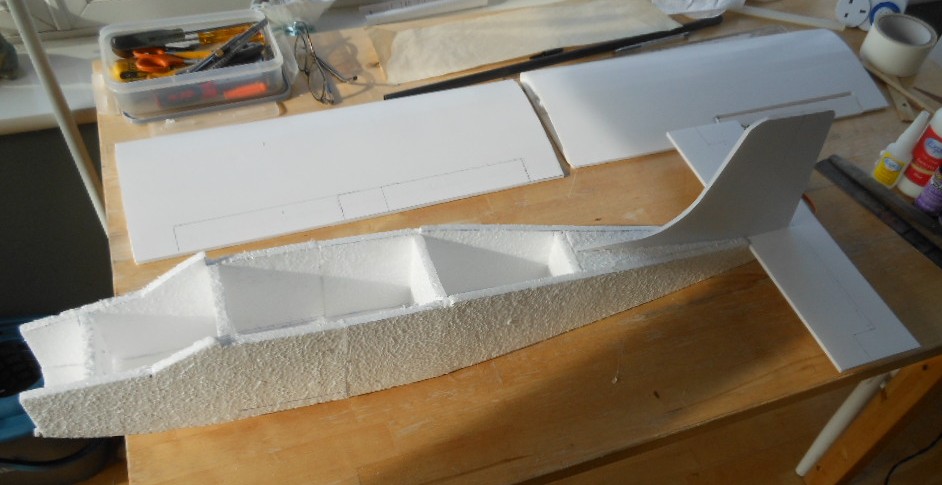 The wings were damaged beyond repair but the fuselage was too good to simply chuck in the bin so Bob modified it slightly and fitted the wings from a one metre span electric powered glider that he’d built during lockdown. He’s named the recycled combo TasLock.
The wings were damaged beyond repair but the fuselage was too good to simply chuck in the bin so Bob modified it slightly and fitted the wings from a one metre span electric powered glider that he’d built during lockdown. He’s named the recycled combo TasLock.
 The powertrain is exactly as it was in the Mini Tasman with a Propdrive 28-36 1400kv motor turning a 9×7 prop, a 40amp speed controller, and a three cell 1300mAh battery.
The powertrain is exactly as it was in the Mini Tasman with a Propdrive 28-36 1400kv motor turning a 9×7 prop, a 40amp speed controller, and a three cell 1300mAh battery.
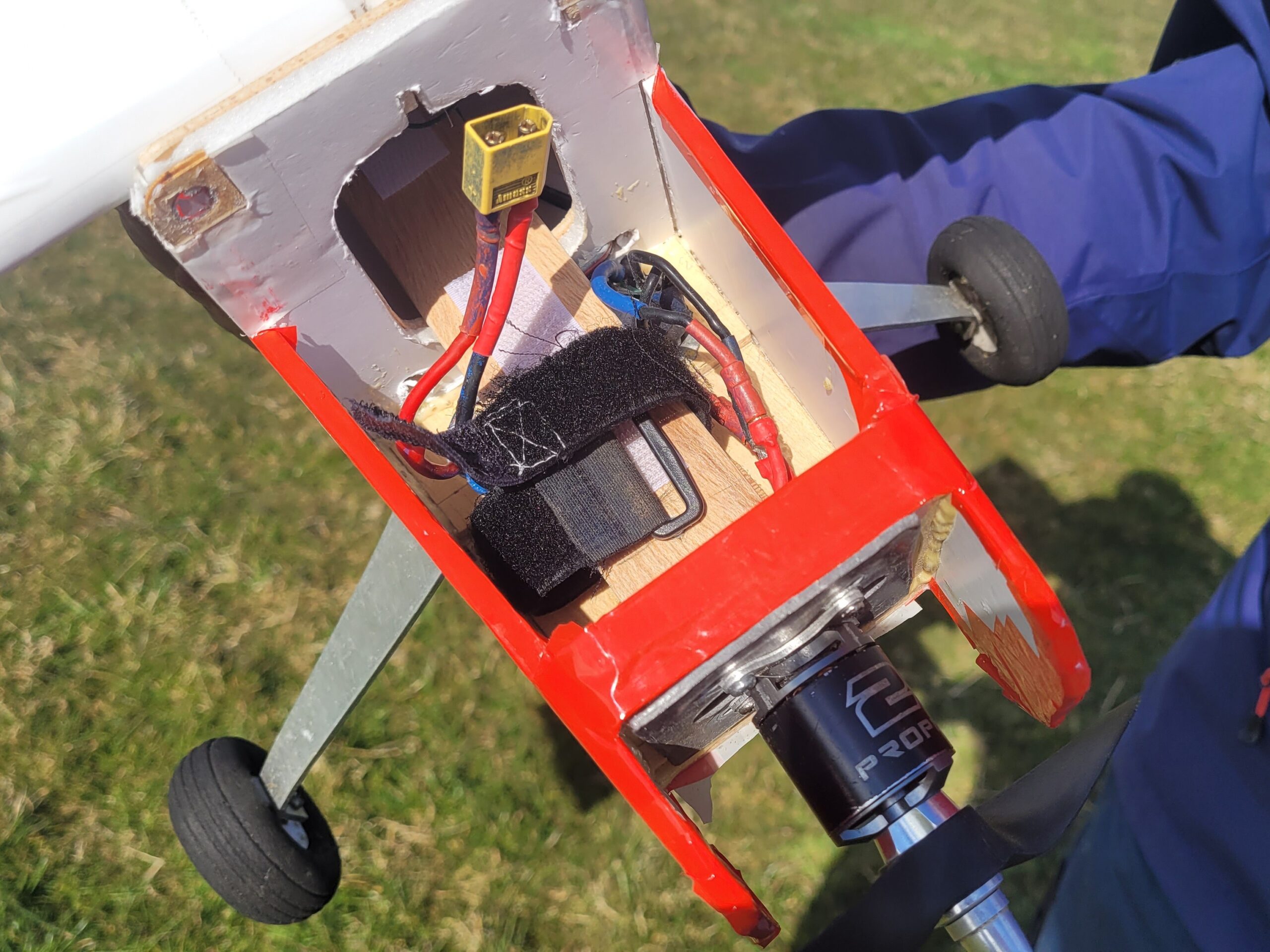 The all up weight is around one kilo which is fine for the size of the wing, but as the wing is slightly swept forward Bob was a little concerned where the centre of gravity should be.
The all up weight is around one kilo which is fine for the size of the wing, but as the wing is slightly swept forward Bob was a little concerned where the centre of gravity should be.
 He obviously got it right as the TasLock flew perfectly with no trims changes required. In Bob’s words “Looks strange but seems fly OK.” He’s right, check it out for in the video.
He obviously got it right as the TasLock flew perfectly with no trims changes required. In Bob’s words “Looks strange but seems fly OK.” He’s right, check it out for in the video.
This month the rather poor quality action photos are all taken from the video:





 Video time now, this month with footage shot by myself, Dougal Entendre, and MacFly.
Video time now, this month with footage shot by myself, Dougal Entendre, and MacFly.
Please watch the video full-screen, it’s so much better with small models flying around:
If the video won’t play for you please click HERE
The Final Funny:
A man in a hot air balloon is lost so he reduces height when he spots a man below.
He lowers the balloon further and shouts, “Excuse me! Can you tell me where I am?”
The man below says “You’re in a hot air balloon hovering 30 ft above this field.”
“You must be an engineer” says the balloonist. The man asked “How did you know?”
“Well”, says the balloonist, “What you have told me is 100% correct but of no use at all.”
The man says “You must be a manager.” The balloonist says “I am, how did you know?”
“Well” says the man “You don’t know where you are, or where you’re going, but you expect me to help. You are in the same position you were before but now it’s all my fault.”
Colin Cowplain
Patch News – July 2025
July was a great month for the club with lots of good weather and great flying enjoyed by the members. As there was little rain the grass barely grew so we only needed to mow once in July. The sheep have gone for now as there’s not enough grass for them to eat.

 As is usual for July, the annual Chuck Glider competition was run mid-month. You’ll find the Competition Secretary’s full report on the event a little later in this Patch News.
As is usual for July, the annual Chuck Glider competition was run mid-month. You’ll find the Competition Secretary’s full report on the event a little later in this Patch News.
First up of the new models is Woody’s lovely foamboard Typhoon that he’s built using the plans from the RC.tohme.net site which you’ll find HERE. The website says to use Depron but Woody has built his from Hobbycraft foamboard, leaving the covering paper on.
 Woody first fitted the Typhoon with a drone motor but the power seemed a bit marginal so after the first flight he swapped the motor to a Turnigy 2212/10. I don’t think the swap made a lot of difference really but it has enough power although certainly not excessive.
Woody first fitted the Typhoon with a drone motor but the power seemed a bit marginal so after the first flight he swapped the motor to a Turnigy 2212/10. I don’t think the swap made a lot of difference really but it has enough power although certainly not excessive.  The speed controller is 30A and Woody is using the usual 3 cell 2200mAh lipo packs.
The speed controller is 30A and Woody is using the usual 3 cell 2200mAh lipo packs.
Woody has finished his in the scheme of a specific RAF Eurofighter Typhoon aircraft, one that is painted in a D-Day commemorative livery. This aircraft, serial number ZJ913, is nicknamed “Moggy” due to the way the letters “FM-G” are arranged around the roundel, resembling “FMOG”. The livery is based on the Hawker Typhoon of 257 Squadron, coded FM-G, flown by Pilot Officer Denzel Jenkins on D-Day. Last year was the 80th anniversary of the D-Day landings, and the aircraft was part of the RAF Typhoon Display Team.
 Woody has made a cracking job of it and it looks great but, oddly for Woody, he hasn’t added any lights, surely a first?! The first flight was ‘interesting,’ Woody asked me to trim it out which I quickly did once it had gone away from the launch. All seemed fine for the next couple of minutes but then it lost radio contact and it dived left into the ground.
Woody has made a cracking job of it and it looks great but, oddly for Woody, he hasn’t added any lights, surely a first?! The first flight was ‘interesting,’ Woody asked me to trim it out which I quickly did once it had gone away from the launch. All seemed fine for the next couple of minutes but then it lost radio contact and it dived left into the ground.
 Woody had previously had a couple of unexplained crashes but had fitted the Typhoon with a different receiver so the transmitter became the prime suspect. The transmitter was a Multiplex Cockpit 7 that I’d sold Woody second-hand a good few years ago. I’ve looked through some old photos and found that I was using the transmitter at least fifteen years ago so it hasn’t done too badly. It still works but there’s obviously an intermittent problem, maybe just the aerial connection or similar. Anyway, Woody decided to bite the bullet and bought himself a new Radiomaster transmitter which is compatible with his Multiplex receivers (and various other brands) so after some repairs to the model we tried again.
Woody had previously had a couple of unexplained crashes but had fitted the Typhoon with a different receiver so the transmitter became the prime suspect. The transmitter was a Multiplex Cockpit 7 that I’d sold Woody second-hand a good few years ago. I’ve looked through some old photos and found that I was using the transmitter at least fifteen years ago so it hasn’t done too badly. It still works but there’s obviously an intermittent problem, maybe just the aerial connection or similar. Anyway, Woody decided to bite the bullet and bought himself a new Radiomaster transmitter which is compatible with his Multiplex receivers (and various other brands) so after some repairs to the model we tried again. 
 Woody has now flown various models using the Radiomaster with no radio troubles so it seems the transmitter was the problem. The Typhoon is now flying well and it looks great in the air. You can see it in this month’s video which includes Moggy diving into the deck!
Woody has now flown various models using the Radiomaster with no radio troubles so it seems the transmitter was the problem. The Typhoon is now flying well and it looks great in the air. You can see it in this month’s video which includes Moggy diving into the deck!
In the May Patch News I reported that Dwayne Pipe had begun repairs of his Folland Gnat following some fairly severe crash damage and in July he brought it along to test fly.

 He discovered that, despite his best efforts, the wing incidence wasn’t the same on both wings which resulted in a built-in left turn that was too much to be trimmed out.
He discovered that, despite his best efforts, the wing incidence wasn’t the same on both wings which resulted in a built-in left turn that was too much to be trimmed out.
 Dwayne got the Gnat down safely twice without any damage so he’s now taken it back to the workshop for a bit of re-jigging. There’s a lot to be said for designing and building a model from scratch, it means almost anything can be fixed and got back in the air.
Dwayne got the Gnat down safely twice without any damage so he’s now taken it back to the workshop for a bit of re-jigging. There’s a lot to be said for designing and building a model from scratch, it means almost anything can be fixed and got back in the air.
Next up is a Dougal Entendre’s Durafly Rare Bear Reno Racer that came from HobbyKing.
 So, what is the model based on? Rare Bear is the nickname of a highly modified Grumman F8F Bearcat aircraft that has competed in the Reno Air Races, specifically in the Unlimited class. It’s known for its speed and has set many performance records for piston-driven aircraft, including the 3 km World Speed Record of 528.33 mph set August 21, 1989, which still stands in this class. Over many years of racing Rare Bear has been painted in various colour schemes including the gold and white livery that Dougal’s is finished in.
So, what is the model based on? Rare Bear is the nickname of a highly modified Grumman F8F Bearcat aircraft that has competed in the Reno Air Races, specifically in the Unlimited class. It’s known for its speed and has set many performance records for piston-driven aircraft, including the 3 km World Speed Record of 528.33 mph set August 21, 1989, which still stands in this class. Over many years of racing Rare Bear has been painted in various colour schemes including the gold and white livery that Dougal’s is finished in.
Here’s what HobbyKing say about the model: Do you feel the need for speed? Then this great-looking, extremely fast Rare Bear Reno Racer from Durafly is for you. It is supplied as a Plug-N-Fly model with minimal parts count, so assembly is quick and simple. There is no gluing required, just one screw holds the tail components in place, and 1 screw for the wing. Battery and radio access is via the large magnetically held canopy hatch, so radio installation and battery changes are very easy and straightforward. Durafly has captured this amazing turn of speed with their Rare Bear, on the stock 4S setup with the supplied 8×5 propeller, speeds of around 110mph are easily achievable. But the Rare Bear is not all about speed; slow it down, and it handles beautifully. The controls work well, right down to the very predictable stall, the Rare Bear is just a joy to fly with no nasty tendencies. Back to when flying at speed, on the stock 4S setup, it flies like it is on rails, and gives that locked-in feel while performing aerobatics, huge loops, and long, smooth knife-edge flight are just a breeze to carry out.  The build quality and attention to detail are typical Durafly, it is just fantastic. The Rare Bear is a hand-launched model and belly lander, so underneath, the fuselage and the wingtips are reinforced with tough plastic to take the knocks and bangs. Additionally, glass fibre reinforcements are on all the control surfaces, which really stiffen them up to stop any flutter at high speeds, and the foam hinge line is reinforced with a clear flexible adhesive. The fuselage is also reinforced inside with glass fibre rods running along the length of each side for added strength. It has a solid plastic firewall, stiff pushrods with ball link connectors for positive control, and the scale mouldings include a dummy exhaust and radiator intake. This Plug-N-Fly model is supplied with a pre-installed 3536-1700KV brushless motor, a 60A Aerostar LITE brushless ESC, 4 x metal-geared 9g servos, and an 8×5 propeller. Once it is assembled, all you require is a 4ch or more transmitter and receiver, and a 4S (14.8V) 1800~2200mAh 40C minimum LiPo battery.
The build quality and attention to detail are typical Durafly, it is just fantastic. The Rare Bear is a hand-launched model and belly lander, so underneath, the fuselage and the wingtips are reinforced with tough plastic to take the knocks and bangs. Additionally, glass fibre reinforcements are on all the control surfaces, which really stiffen them up to stop any flutter at high speeds, and the foam hinge line is reinforced with a clear flexible adhesive. The fuselage is also reinforced inside with glass fibre rods running along the length of each side for added strength. It has a solid plastic firewall, stiff pushrods with ball link connectors for positive control, and the scale mouldings include a dummy exhaust and radiator intake. This Plug-N-Fly model is supplied with a pre-installed 3536-1700KV brushless motor, a 60A Aerostar LITE brushless ESC, 4 x metal-geared 9g servos, and an 8×5 propeller. Once it is assembled, all you require is a 4ch or more transmitter and receiver, and a 4S (14.8V) 1800~2200mAh 40C minimum LiPo battery.  Unfortunately, when Dougal first unboxed the model he found one of the aileron servos was faulty so he replaced it, but the first time he brought it to the field there was a problem with the replaced servo glitching so he couldn’t fly. Checking it out at home he found it was getting very hot so he’s now binned it and has fitted another from his stock. He got onto HobbyKing who sent two replacement servos but they were plastic geared ones, not metal, and the plane definitely needs metal geared servos. Once the servo saga was sorted I filmed the first attempt at flight which didn’t go quite to plan! Chas’s launch was fine but the Rare Bear torque rolled hard left and it cartwheeled right in front of me.
Unfortunately, when Dougal first unboxed the model he found one of the aileron servos was faulty so he replaced it, but the first time he brought it to the field there was a problem with the replaced servo glitching so he couldn’t fly. Checking it out at home he found it was getting very hot so he’s now binned it and has fitted another from his stock. He got onto HobbyKing who sent two replacement servos but they were plastic geared ones, not metal, and the plane definitely needs metal geared servos. Once the servo saga was sorted I filmed the first attempt at flight which didn’t go quite to plan! Chas’s launch was fine but the Rare Bear torque rolled hard left and it cartwheeled right in front of me.
 Amazingly there was no damage so Chas launched it again, this time with Dougal using less throttle. Although it rolled left again Dougal was prepared for it and the plane got away safely, and on subsequent flights Dougal has found that half throttle is the absolute maximum power when launching. Once safely away the performance is amazing, Dougal only uses full throttle for very short bursts as it’s so fast! He says it’s really nice to fly and doesn’t seem to have any nasty characteristics. The video includes the first launch and then some of the flying but it’s too fast for me to get much decent film of it.
Amazingly there was no damage so Chas launched it again, this time with Dougal using less throttle. Although it rolled left again Dougal was prepared for it and the plane got away safely, and on subsequent flights Dougal has found that half throttle is the absolute maximum power when launching. Once safely away the performance is amazing, Dougal only uses full throttle for very short bursts as it’s so fast! He says it’s really nice to fly and doesn’t seem to have any nasty characteristics. The video includes the first launch and then some of the flying but it’s too fast for me to get much decent film of it.
As I mentioned earlier, July is Chuck Glider Competition time and our Competition Secretary Dwayne Pipe got everything arranged for the event to be held in the evening of 9th July at the Buriton playing fields. Here is Dwayne’s report: The annual chuck glider competition was held this month, and as usual in the middle of July the conditions were perfect. We had nine people turn up and all took part in the competitions. In the standard Chuck glider category it will come as no surprise to learn that Colin Cowplain won with a significant lead over everybody else. His consistent times are part of the key to his success as his overall time of 58 seconds this year was almost the same as his time last year of 56.1 seconds. Second place was won by 1066 who entered for the first time and had a creditable time of 38 seconds and Tony Neil came third.
 We also had the Catapult glider competition as well, and for this the results were completely different. Dwayne Pipe came first with a time of 79.1 seconds, and Colin Cowplain second with a time of 53.4 seconds and Dougal Entendre third. Everyone seemed to have a good time. I would recommend for next year that you get lots of practise in trimming your aircraft before you turn up on the night.
We also had the Catapult glider competition as well, and for this the results were completely different. Dwayne Pipe came first with a time of 79.1 seconds, and Colin Cowplain second with a time of 53.4 seconds and Dougal Entendre third. Everyone seemed to have a good time. I would recommend for next year that you get lots of practise in trimming your aircraft before you turn up on the night.
Thanks for the report and for arranging and running the comp Dwayne. I’ve added some brief clips of the flying to this month’s video, with the best flight I’ve included being one of mine (obviously!). I’ll add some photos of the evening to the Action Shots section below. It’s always a fun evening and everyone seems to enjoy it, including dog walkers etc who seem bemused by a bunch of (mostly) old men chasing little balsa wood toys around!
At the field one day 1066 mentioned that he’d spotted a Volantex Phoenix for sale on Facebook Marketplace and that it would be perfect for Woody who was looking for a replacement for his Max-Thrust Aggressor. After lots of persuasion by others Woody agreed to check it out and Captain Slow took him down to Portsmouth to take a look.
It turned out that the seller was a guy who had previously sold 1066 a model that had turned out to be a very good buy so he was known to be an honest, decent seller.
 The model advertised was a Phoenix Evolution that has a wingspan of 1.6m but also comes with an additional centre section that can be fitted which takes the span up to 2.6m.
The model advertised was a Phoenix Evolution that has a wingspan of 1.6m but also comes with an additional centre section that can be fitted which takes the span up to 2.6m.
 I have an older version Phoenix 1600 and can vouch for its excellent flying characteristics; it’s a reasonable glider but is also excellent for aerobatics. The Evolution has a slightly different wing shape to mine but looks to be basically the same model apart from having the extra wingspan available that would obviously increase its gliding capabilities greatly.
I have an older version Phoenix 1600 and can vouch for its excellent flying characteristics; it’s a reasonable glider but is also excellent for aerobatics. The Evolution has a slightly different wing shape to mine but looks to be basically the same model apart from having the extra wingspan available that would obviously increase its gliding capabilities greatly. 
 Woody reckons the Phoenix has never been flown so with the seller asking just £65 for it, just needing a receiver and battery, it was a great deal. Dougal did the initial trimming while I filmed and the Phoenix flew perfectly, with Dougal saying it was really nice to fly. Woody quickly took the controls and was very happy with the way that it handled.
Woody reckons the Phoenix has never been flown so with the seller asking just £65 for it, just needing a receiver and battery, it was a great deal. Dougal did the initial trimming while I filmed and the Phoenix flew perfectly, with Dougal saying it was really nice to fly. Woody quickly took the controls and was very happy with the way that it handled.
 I haven’t had a chance to fly it myself yet but I doubt it’ll be very different to mine.
I haven’t had a chance to fly it myself yet but I doubt it’ll be very different to mine.
Dwayne Pipe has been building again, this time he’s built a Dancing Wings Piper J3 Cub from a kit given to him by 1066. Here’s Dwayne’s rather sad tale of how the building went: Dancing Wings advertise a 1.2 metre Piper J3 cub as a balsa construction kit. The price of between £80 to £90 on the face of it seems reasonable, and one of our illustrious members forked out and bought it. (It’s alright Dwayne, we know it was 1066!)
According to the blurb in the instruction manual: The Piper J3 cub was the most popular commercial aircraft of the 1930s? Barely 7 yards long and instantly recognisable in its yellow and black paint scheme, this nostalgic favourite became the foremost trainer of the era? Eventually training 80% of the United States military pilots by the end of World War 2. A new Cub was rolling off the assembly line nearly every 20 minutes and many of these beloved aeroplanes are still around today.

The quality of the wood was appalling, the instructions confusing and the kit seems to be designed by someone who has never actually flown the plane. On the positive side the laser cut parts fit together well. 1066 started to build it and realised it was going to be a challenge with no guaranteed success. So, he gave it to me, and two months later after a lot of frustration and redesigning large parts of it, the Piper cub is ready to fly.
 The Dancing Wings model has a wingspan of 1200mm, a length of 725 mm and an alleged flying weight of 750g. Mine actually has an all-up weight of 1100g.
The Dancing Wings model has a wingspan of 1200mm, a length of 725 mm and an alleged flying weight of 750g. Mine actually has an all-up weight of 1100g.
I fitted a 30A esc, a 1000kv motor and a 10×6 prop (now changed to a 9×6 prop).
 Progress to date. It refused to take-off from the ground due to severe ground looping.
Progress to date. It refused to take-off from the ground due to severe ground looping.
A hand launch showed that the control surface deflections in the instructions are far too high and the planes first flight lasted about ten seconds with moderate damage.
 Repairs have been made, larger wheels fitted, a new smaller prop installed.
Repairs have been made, larger wheels fitted, a new smaller prop installed.
The challenge continues.

The moral of this story is don’t buy a Dancing wings kit unless you have a lot of experience building balsa planes and unlimited patience. Thanks for the report Dwayne, it’s a great shame the quality of the kit was so bad and that so far it hasn’t flown properly.
I filmed the first three attempts at flight so far, you can see them in this month’s video. Since then Dwayne has had a couple more attempts and is gradually getting the problems sorted but at the time of writing the Cub still has some way to go before flying properly.
This month the action shots were taken during the annual chuck glider competition.





Video time now, this month with footage shot by me, MacFly, and Dougal Entendre. Please watch the video full-screen, it’s so much better with small models flying around.
If the video won’t play for you please click HERE
Final Funny:
Two hunters from Ireland were on holiday in Canada and they hired a pilot to fly them to hunt moose. Over the next couple of days they bagged six between them.
As they started loading the plane for the return trip home, the pilot tells them the plane can take only three moose. The two men objected strongly, saying “Last year we shot six moose and the pilot let us put them all on board and he had the same plane as yours.”
Reluctantly, the pilot gave in and all six were loaded. Unfortunately, even on full power, the little plane couldn’t handle the load and went down a few minutes after take off.
Climbing out of the wreckage, Paddy asked Mick “Have you any idea where we are?”
Mick replied, “I think we’re pretty close to where we crashed last year.”
Colin Cowplain

